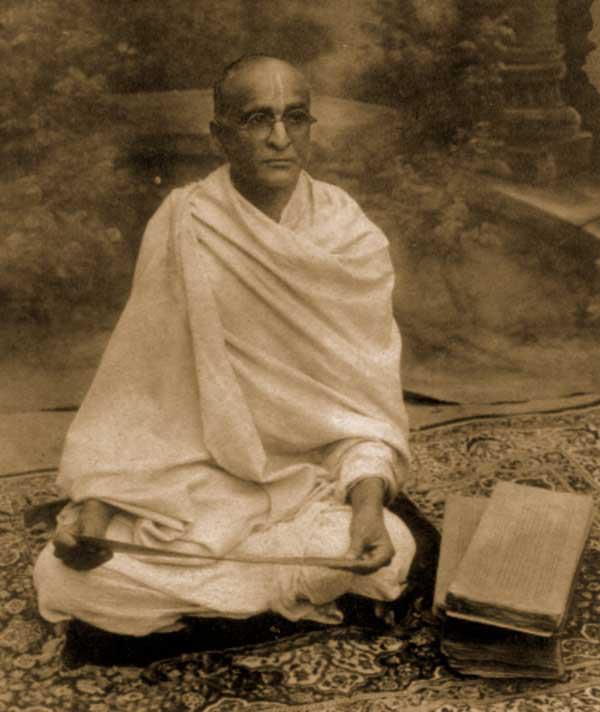
1936 was to be the last year of the intense preaching which had resulted in 64 temples being established in India and abroad. During this final year Srila Bhaktisiddhanta Sarasvati Thakur met with many scholars, installed Deities, established more temples and preached widely in Mayapur, Cuttack, Puri (for 100 days), Alalanatha, Dacca, Kuruksetra, Darjeeling, Mathura, Vrindavan (where he established a bhajan kutir at Govardhan) and then back to Calcutta, where he was constantly engaged in preaching. A doctor named Sivapada Bhattacarya tried to restrain him from so much lecturing, due to his heart condition, but Srila Bhaktisiddhanta Sarasvati Thakur replied to his entreaties:
Life is for the glorification of topics on Hari. If that is stopped, then what need is there to carry on life.
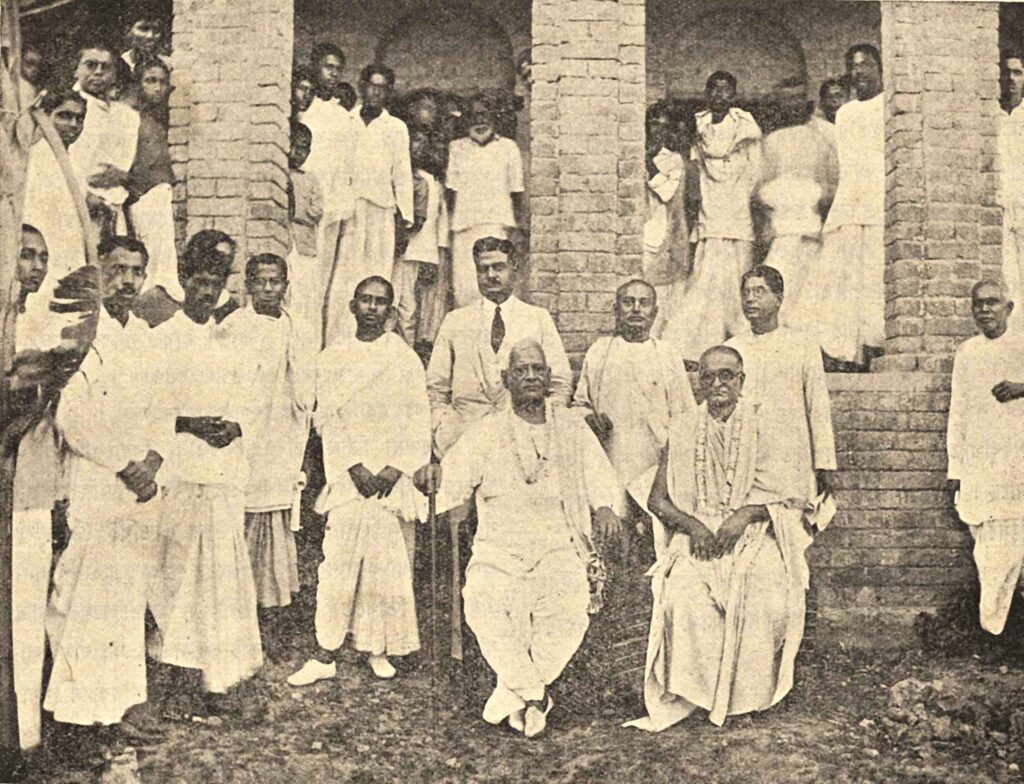
In that same year in discourses in Dacca, he had made some revealing remarks along the same lines:
Physical illness with Hari-bhajan is preferred to physical fitness sans (without) Hari-bhajana. Our span of life on earth is short. Our life will be crowned with success if the body wears out with constant discourses on Hari.
At these Dacca meetings, he uttered many enlightening remarks which could top anyone’s list of profound sayings. Those below shed light on the actions and attitudes necessary to succeed in spiritual life:
We are here on earth not to work as artisans for making big buildings with wood and stone but to work only as messengers of the teachings of Sri Chaitanya Deva.
We are put to test and trial in this world. Only those who attend the kirtan of the devotees can succeed.
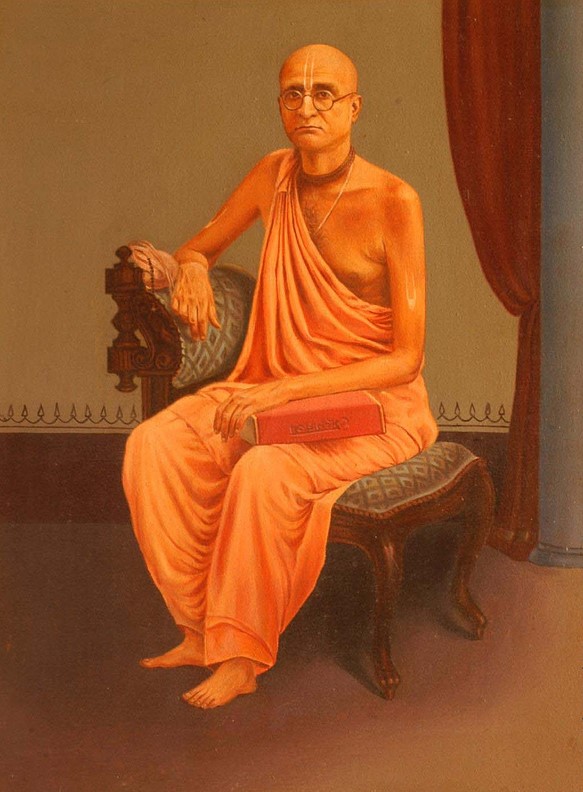
A sychophant (self-serving flatterer) is neither a guru or a preacher.
To transform the adverse desires of the Jivas is the supreme duty of the most merciful. To rescue one person from the stronghold of Mahamaya is an act of superb benevolence, far superior to opening innumerable hospitals.
Every spot on earth where discourses on God are held is a place of pilgrimage.
Possession of objects not related to Krishna is our main malady.
Let me not desire anything but the highest good for my worst enemies.
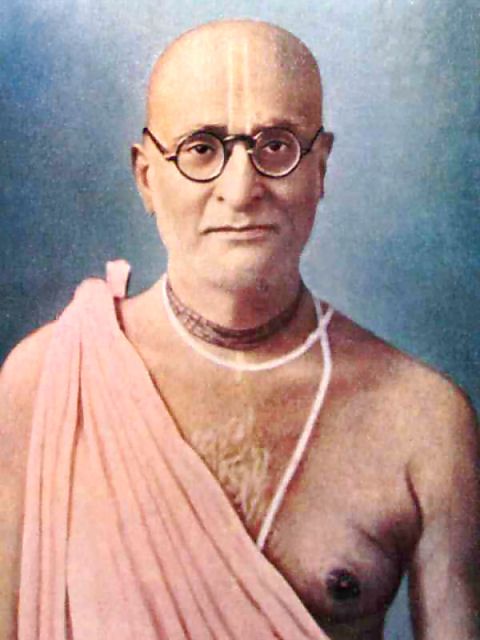
Unless we are devoted to God, secularism shall not leave us.
As dalliance with the body in luxury increases, so wanes the spirit of service for the Lord.
Those favoured by God find their paths set by thorns.
There is no peace or happiness in our worldly life. Circumstances create turmoil and annoyance.
Chant the maha-mantra loudly and with attachment. This will drive away inertia, worldly evils and pests.
Be indifferent to bazaar gossips, stick firmly to your cherished goals, no lack or impediments of the world will ever stand in your way.
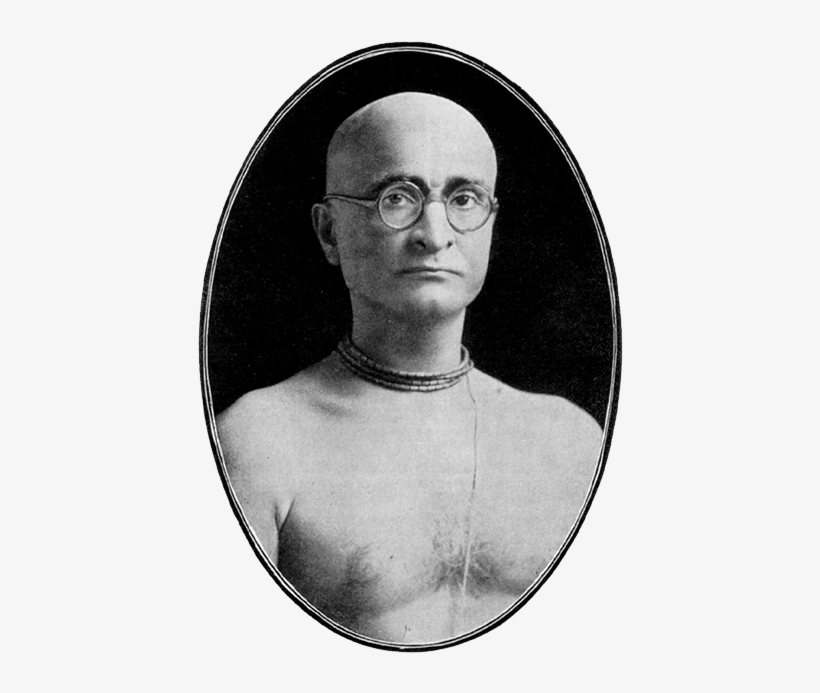
Pay due respects to the extroverts of the world, but do not be appreciative of their manners and conduct. They are to be shaken off from your mind.
A devotee feels the presence of God everywhere, but one averse to the Lord denies His existence anywhere.
You cannot appreciate transcendental matters with the reasoning of the world. It is sheer nonsense to decry them with the measuring stick of your intellect.
To recite the name of Sri Krishna is bhakti.
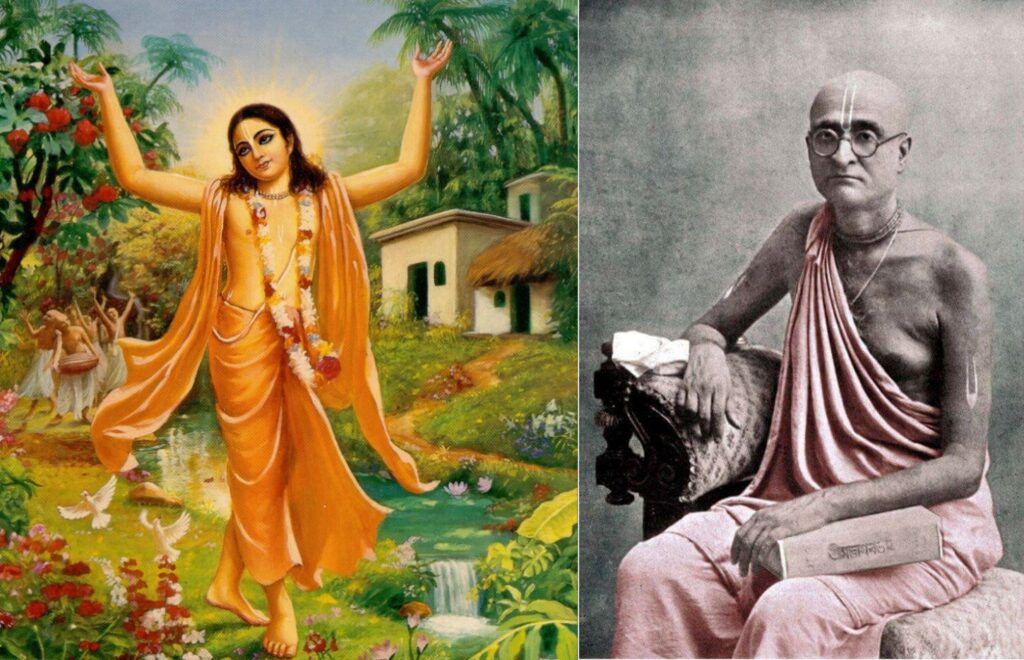
There is a very wonderful passage of spiritual instruction by Srila Bhaktisiddhanta Sarasvati on the power of the holy name found in the book Sri Bhaktisiddhanta Vaibhava:
I am overjoyed to hear that your enthusiasm for chanting is increasing. As our contaminations are removed by chanting, the Lord’s form, qualities, and pastimes will be revealed to us in the holy name. There is no point in making a separate effort to artificially remember the Lord’s form, qualities, and pastimes. The Lord and His name are one and the same. This will be understood clearly when the coverings in your heart are removed.
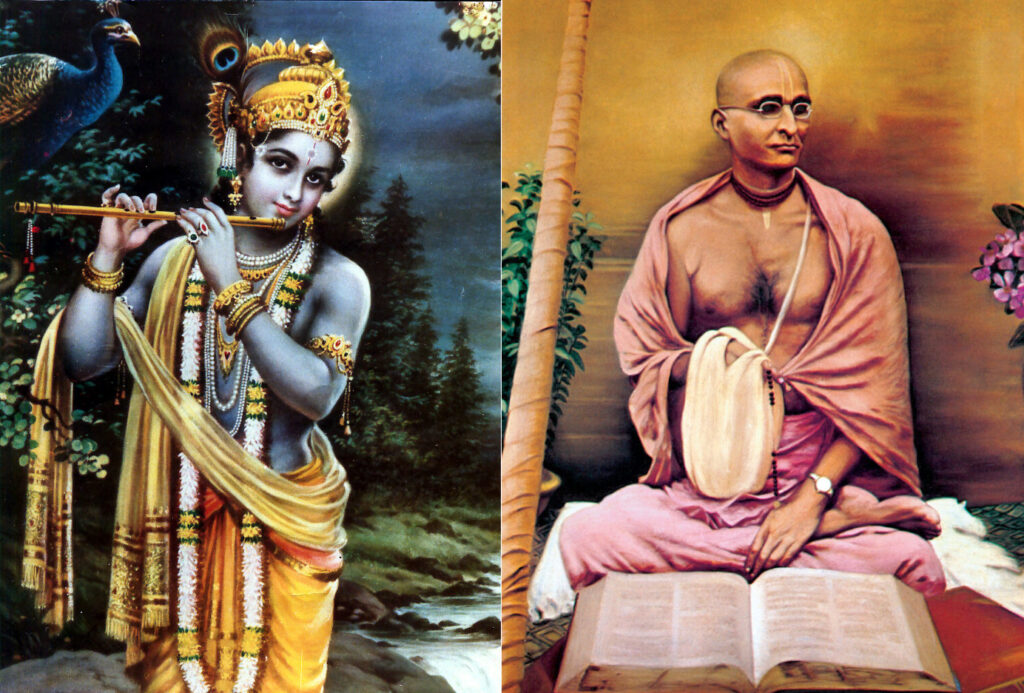
By chanting without offenses you will personally realize that all perfections come from the holy name. Through chanting, the distinction that exists between the self, and the gross and subtle bodies, is gradually effaced and one realizes one’s own spiritual form. Once aware of the spiritual body, as one continues to chant, one sees the transcendental nature of the Lord’s form.
Only the holy name reveals the spiritual form of the living being and then causes him to be attracted to Krishna’s form. Only the holy name reveals the spiritual qualities of the living being and then causes him to be attracted to Krishna’s qualities. Only the holy name reveals the spiritual activities of the living being and then causes him to be attracted to Krishna’s pastimes.
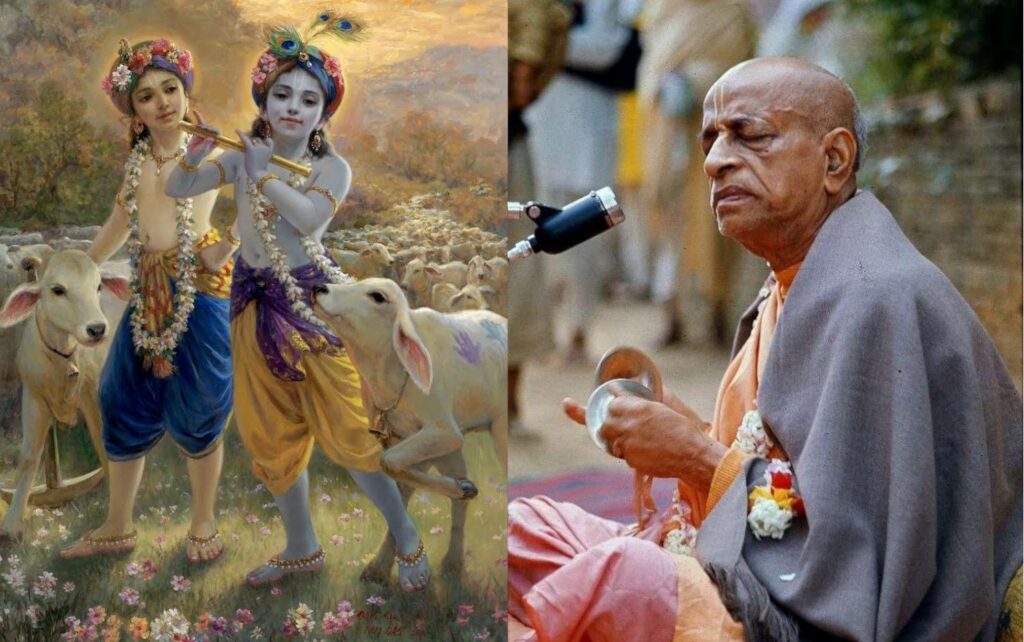
By service to the holy name we do not mean only the chanting of the holy name; it also includes the other duties of the chanter. If we serve the holy name with the body, mind, and soul, then the direction of that service spontaneously manifests like the sun in the clear sky of the chanter’s heart. What is the nature of the holy name?
Eventually all these understandings spontaneously appear in the heart of one who chants the holy name. The true nature of hari-nama is revealed by listening to, reading, and studying the scriptures. It is unnecessary to write anything further on this subject. All these things will be revealed to you through chanting.
[Srila Bhaktisiddhanta Sarasvati Thakur from Bhaktisiddhanta Vaibhava]
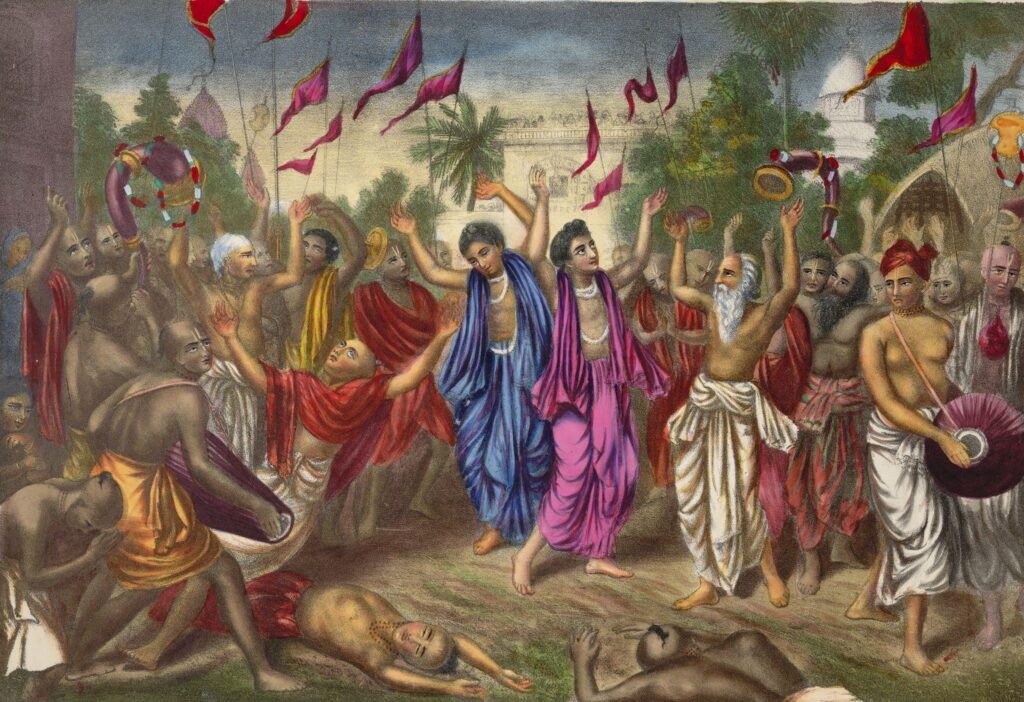
At one time, Srila Bhaktisiddhanta Sarasvati gave a heavy class on detachment from material life. Then later, while writing, he saw a monkey stealing bananas from the storage shed which was just next to his study. He ran out with a stick to chase the monkey away, overturning his writing table and spilling ink on the pages of his manuscript. When the cook saw this, he inquired, “Today you instructed us that one must become detached. But I cannot understand your behaviour. Just now, for only two bananas, you jumped from your writing to chase a monkey, and even ruined your work in the process?” Bhaktisiddhanta Saraswati answered:
These bananas belong to Srimati Radharani, because they are to be used in Krishna’s service.

At the Yogapitha temple in Mayapura, there was a cook who was very passionate. He fought with every devotee there except for Srila Bhaktisiddhanta himself. Then one day he died. After the funeral ceremony was completed, the Gaudiya Math brahmacaris were sitting together and talking about how much trouble they’d had with the cook. Each was telling stories about the fights he’d had with him. Suddenly, Srila Bhaktisiddhanta Saraswati appeared at the doorway and said:
He always washed his dhoti nicely and was very clean.
From that point on, nobody dared say anything negative about that cook.
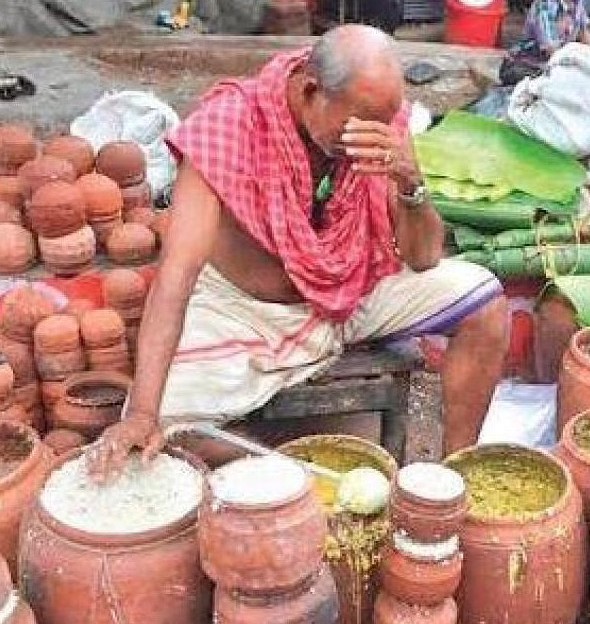
At one time, Srila Sarasvati Thakur and some of his disciples were riding on a train from Calcutta to Puri. They had with them a bag of mangoes which had been donated to the party earlier. Because Srila Bhaktisiddhanta Sarasvati Thakur had taken a childhood vow not to eat mangoes, he would not eat them, and nor would any of his disciples in his presence. The mangoes were starting to go rotten. At this time, an impersonalist (mayavadi) sadhu started preaching monistic philosophy – that it is “all one” – to the great Vaisnava and his students. Srila Bhaktisiddhanta Sarasvati then ordered his students to feed the sadhu the rotten mangoes, saying if it is all one, there is no difference between rotten mangoes and ripe mangoes. After eating four of the rotten mangoes, the impersonalist sadhu fell at Bhaktisiddhanta Sarasvati’s feet, swearing that he would never preach monistic philosophy again.
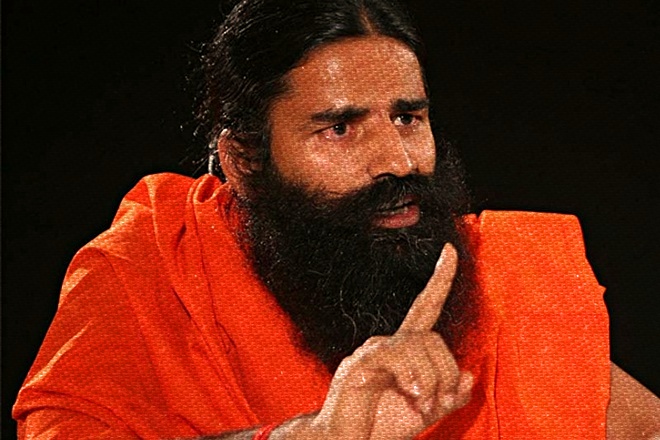
In October of 1936 Srila Bhaktisiddhanta Sarasvati Thakur sent a sanyasi disciple to preach in England and, if possible, America. His other preachers had not been able to accomplish anything very substantial after three years of preaching abroard. They had met many scholars and dignitaries, and there was one woman who had started a center in England, but beyond that none of their preaching had established any sizeable centers, despite great expenditure on the effort. In England, Bhakti Saranga Maharaja met Lord Zetland, who had very favourably received the first preachers and arranged various conferences for them. The English lord asked him:
Swamiji, can you make us into brahmanas?
The reply was forthcoming: “Yes, why not.” When the lord inquired about the restrictions, Bhakti Saranga Maharaja replied:
No meat-eating, no illicit sex, no intoxication and no gambling.
The lord’s astounded reply was:
Impossible! That is my life.
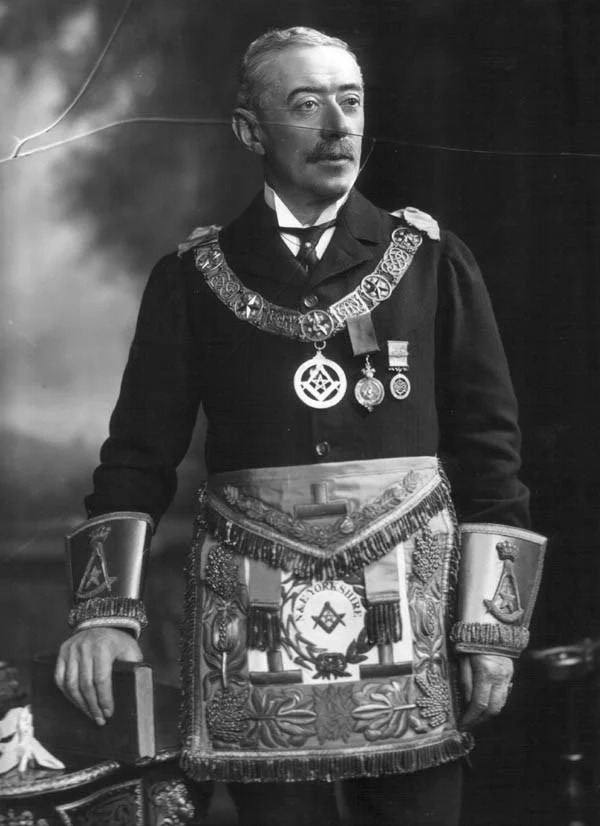
Lord Zetland
And that had reflected the conclusion of those preachers – that to actually turn these foreign mlecchas (meat eaters) into followers of Vedic culture was practically impossible. It continued to appear impossible with the exception of an English lady and some German scholars who became Srila Bhaktisiddhanta Sarasvati Thakur’s disciples – until Srila Bhaktivedanta Swami came to the West and exhibited the transcendental empowerment bestowed upon him by the grace of Srila Bhaktisiddhanta Sarasvati Thakur and Lord Gauranga.
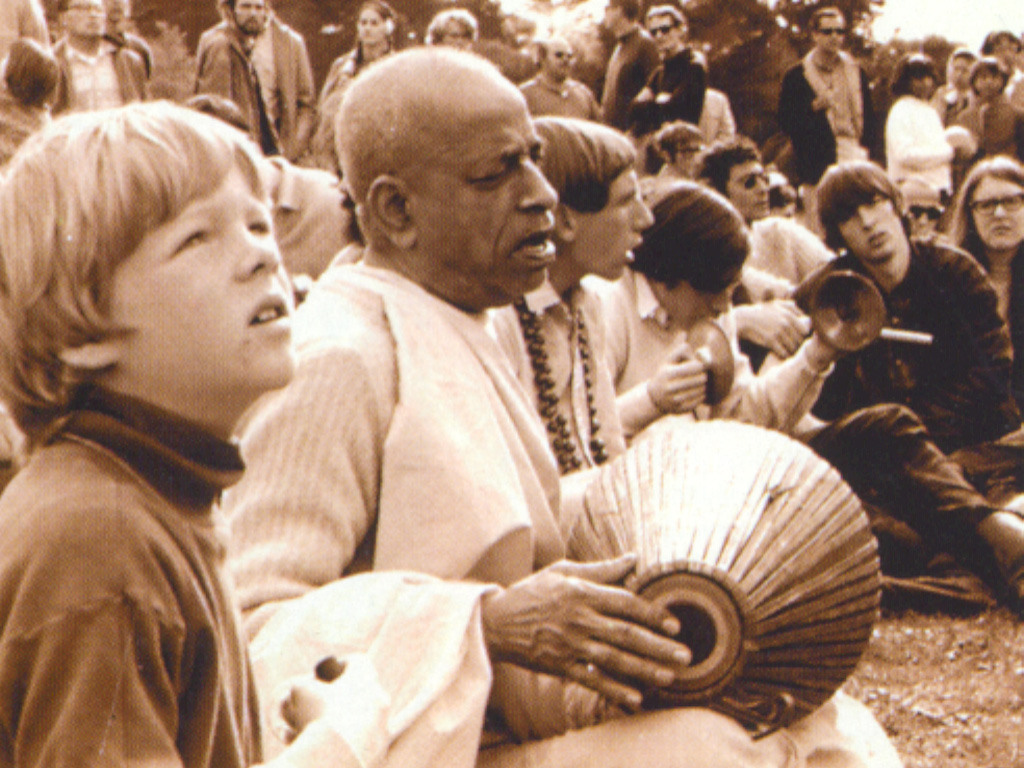
In October of 1936, Srila Bhaktisiddhanta Sarasvati Thakur went to Jagannath Puri, where he was ill for some time. He visited Chataka-parvata, which is considered to be non-different from Govardhan Hill. Chataka-parvata is a sand dune hill in the vacinity of the Tota Gopinath temple at Jagannath Puri. On top of the hill there is now a Gaudiya Math temple and the bhajan kutir of Srila Bhaktisiddhanta Sarasvati Thakur. In this bhajan kutir are Deities of Gaura-Gadadhara, Radha-Krishna and Vyasadeva and Madhvacarya, as well as Srila Bhaktisiddhanta Sarasvati’s bed.
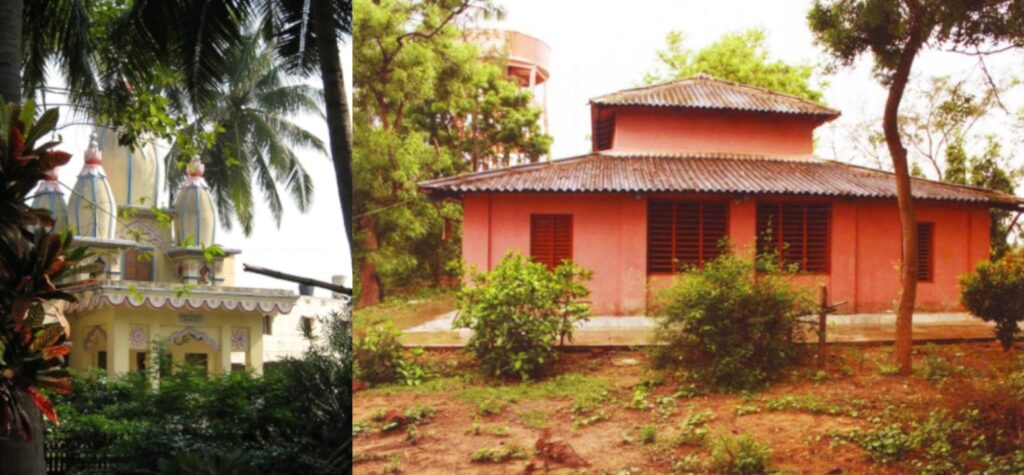
Gaudiya Math Temple and Bhaktisiddhanta’s Bhajan kutir at Chataka-parvata at Puri
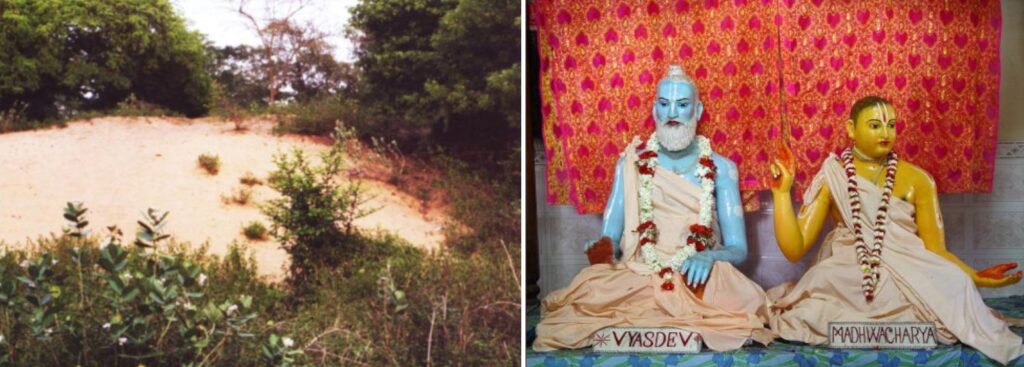
Chataka-parvata sand dune and deities of Vyasadeva and Madhvacarya
At present, Chataka-parvata is visible as a raised heap of sand in front of the Tota Gopinath temple. That the hill is not different from Govardhan Hill in Vrindavan is explained in a pastime of Lord Chaitanya described in the Caitanya-caritamrta’s Antya Lila:
… One day, while Sri Chaitanya Mahaprabhu was going to the sea to bathe, He suddenly saw a sand dune named Cataka-parvata. Sri Chaitanya Mahaprabhu mistook the sand dune for Govardhana Hill and ran toward it. Lord Chaitanya said:
“Of all the devotees, this Govardhana Hill is the best! O my friends, this hill supplies Krishna and Balarama, as well as Their calves, cows and cowherd friends, with all kinds of necessities — water for drinking, very soft grass, caves, fruits, flowers and vegetables. In this way the hill offers respect to the Lord. Being touched by the lotus feet of Krishna and Balarama, Govardhana Hill appears very jubilant.” [This is a quote from Srimad Bhagavatam 10:21:18]
[Caitanya-caritamrta Antya Lila 14:84-86]
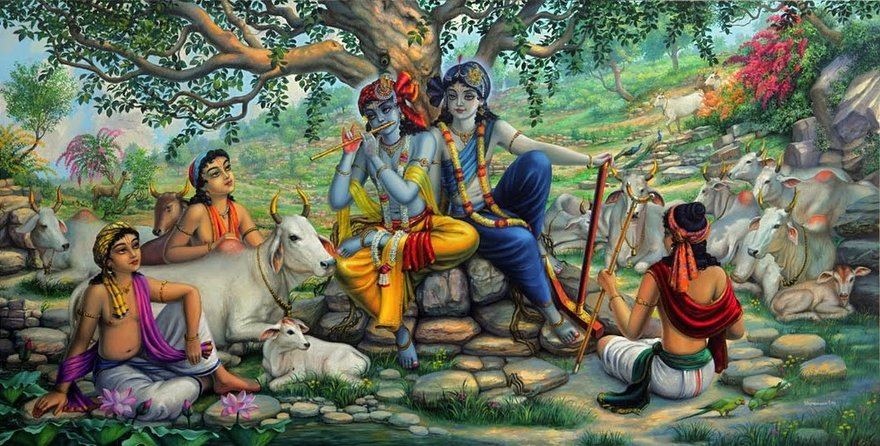
Lord Chaitanya then ran toward Chataka-parvata, where he experienced extreme symptoms of ectasy, falling into a trance until he was awakened by the loud chanting of his devotees. The Lord then said:
Who has brought Me here from Govardhana Hill? I was seeing Lord Krishna’s pastimes, but now I cannot see them. Today I went from here to Govardhana Hill to find out if Krishna was tending His cows there. I saw Lord Krishna climbing Govardhana Hill and playing His flute, surrounded on all sides by grazing cows. Hearing the vibration of Krishna’s flute, Srimati Radharani and all Her gopi friends came there to meet Him. They were all very nicely dressed. When Krishna and Srimati Radharani entered a cave together, the other gopis asked Me to pick some flowers. Just then, all of you made a tumultuous sound and carried Me from there to this place.
[Caitanya-caritamrta Antya Lila 14:105-110]
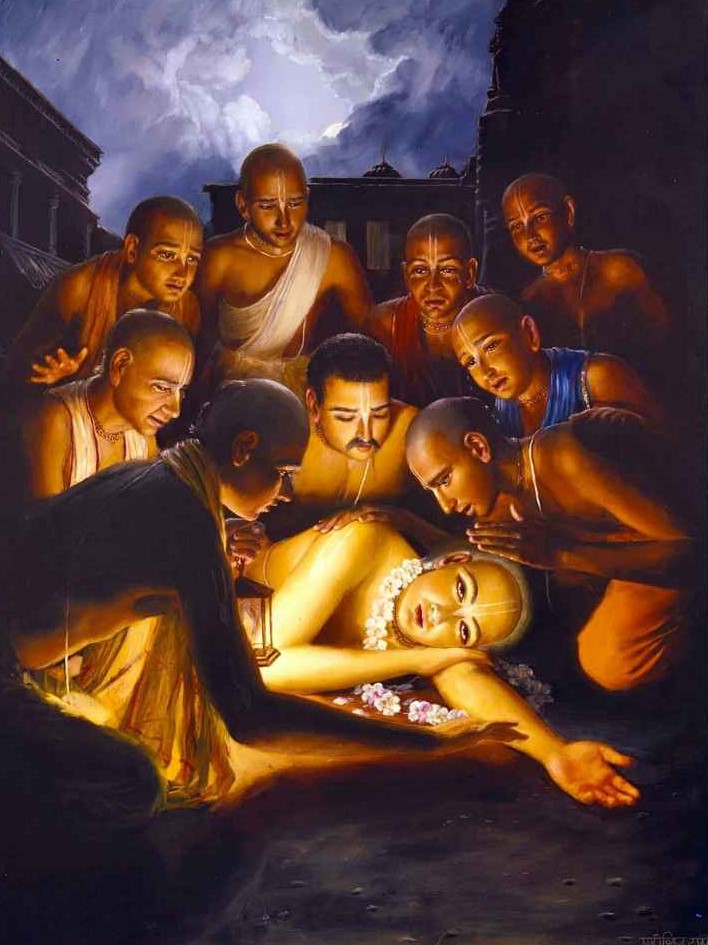
While at Chatak-parvata, Srila Bhaktisiddhanta Sarasvati Thakur observed Madhvacarya’s Appearance Day celebration and chanted verses specified for such occasions from the writings of Srila Rupa and Srila Raghunath Das Gosvami’s writings. He also held a similar festival for his spiritual master, Srila Gaurakisora Das Babaji Maharaja. While he was passing his days in Puri, he was often heard to utter phrases from the verses of Srila Rupa Gosvami and Srila Raghunath Das Gosvami, which translate as:
Oh Govardhan! Please fulfill my desire. Oh Govardhan! Please give me a dwelling place on the banks of the pond near You.

Kusum Sarovar near Govardhan
He also said pointedly:
You all take to sincere Hari-bhajan. There are not many more days.
He gave lectures in Puri for about a month and a half, and then on December 6th he left Puri for Calcutta. At the Puri station he was paid respects by many distinguished persons, who appreciated his monumental activities of preaching Sri Chaitanya Mahaprabhu’s message in India and abroad. Along the route there was a stop in Cuttack, where he was met by Professor Sanyal and other followers, and in Calcutta many devotees greeted him at Howrah Station and brought him to the Gaudiya Math at Baghbazar.
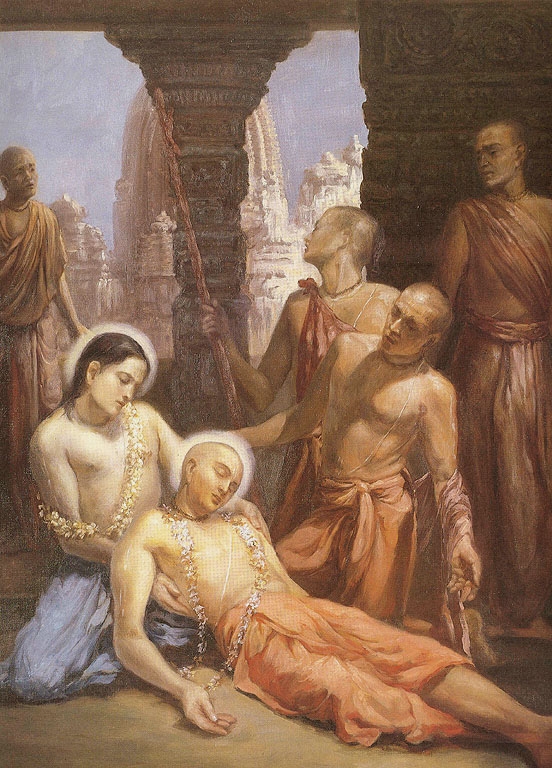
There he gave a lecture which lasted over an hour, and he covered many profound topics. He spoke of the importance of good association, the mystery of Lord Chaitanya’s apparent madness due to separation in Puri, during the last days at the Gambhira in the association of Srila Svarup Damodar and Srila Ramananda Raya. He also spoke of the guru’s vision of seeing his guru everywhere:
It is my Gurudeva who is graciously present in all these different forms. If he is not graciously present in all these different forms, who would then preserve me? Those whom my Gurudeva has made his own are my saviours. The order of the gurus who have in their nature the protecting power of the Divinity, are always present in different forms and figures to bestow their mercy on me. All of them are specific manifestations of Sri Guru who confers spiritual knowledge. …
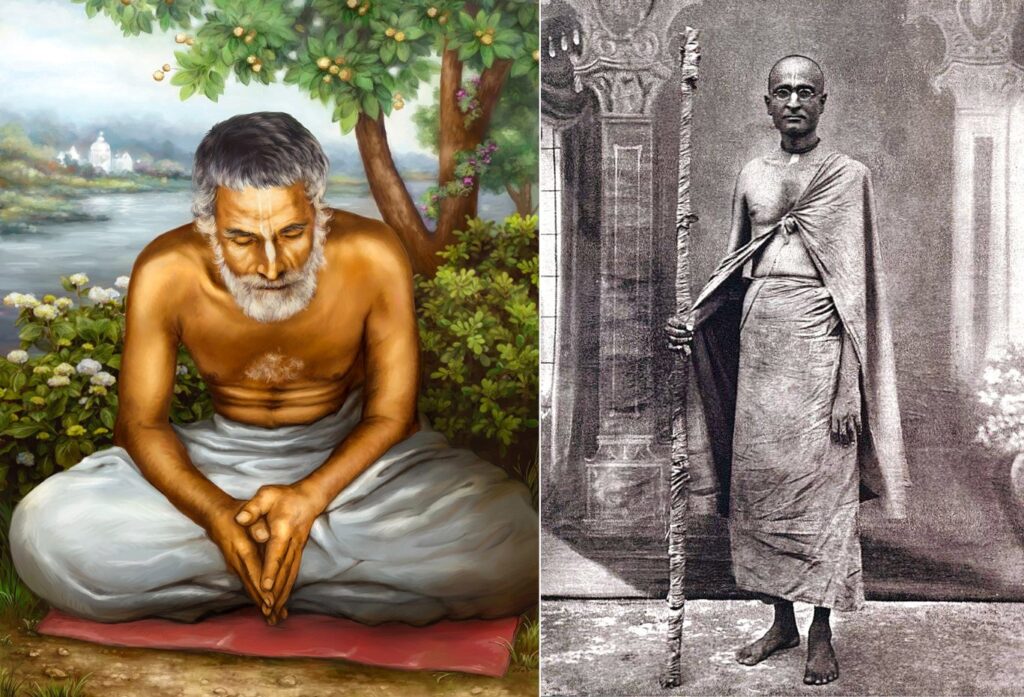
The transcendental reflections, which are also of the nature of supporters, and the worship of the Divinity, which appear in the different planes of cognitive existences, are my Gurudeva in His different forms. He who is constantly showing us how to serve Godhead throughout life, is no other than our Sri Gurudeva. Sri Gurudeva is present in every object as the supporting principle. He is graciously present in every object.
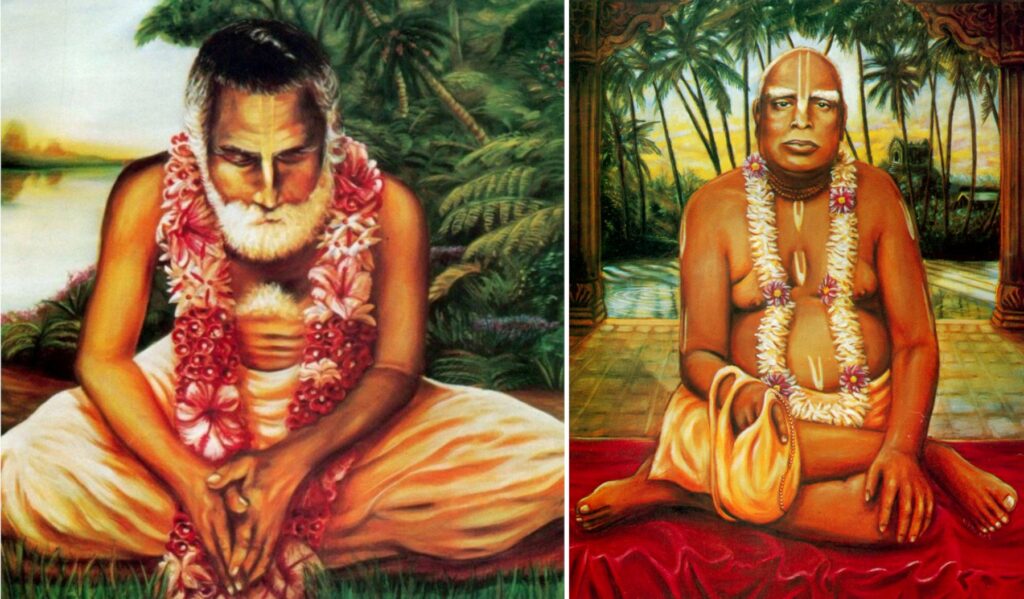
He quoted the line from Raghunath Das Gosvami’s Manah Siksa: sada dambham hitva – Please give up all pride. He discussed the necessity of being careful about offenses to Vaisnavas, especially in connection to the following verse from the Caitanya-caritamrta:
According to their karma, all living entities are wandering throughout the entire universe. Some of them are being elevated to the upper planetary systems, and some are going down into the lower planetary systems. Out of many millions of wandering living entities, one who is very fortunate gets an opportunity to associate with a bona fide spiritual master by the grace of Krishna. By the mercy of both Krishna and the spiritual master, such a person receives the seed of the creeper of devotional service.
[Caitanya-caritamrta Madhya 19:151]
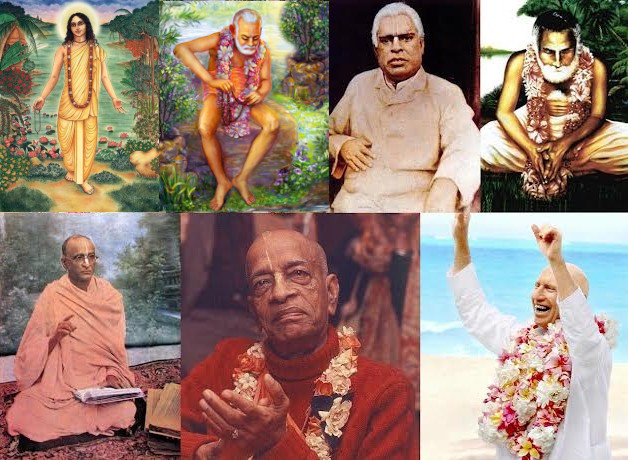
Srila Sarasvati Thakur quoted from Srila Bhaktivinoda Thakur’s Saranagati, from the Dainya (Humility) section, which begins:
I am an impious sinner and have caused others great anxiety and trouble.
In this wonderful prayer we glimpse the humility of a great Vaisnava – Srila Bhaktivinoda Thakur is feeling himself to be a grossly sinful, materialistic person. The translation, which perfectly describes the life of an envious materialist, serves to shed light on the negative qualities we must overcome in our own endeavour for self-realization. And it is apparent that even a self-realized person, in his deep humility, feels that he still possesses these faults:
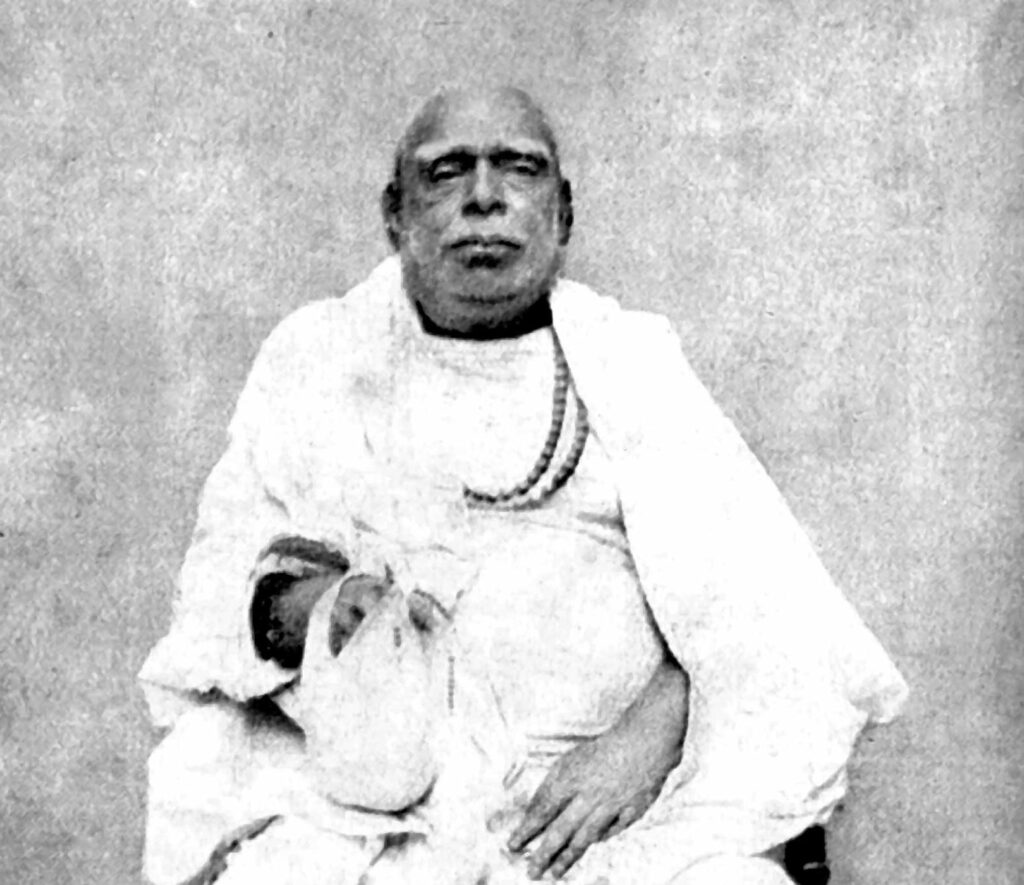
1. I am an impious sinner and have caused others great anxiety and trouble.
2. I have never hesitated to perform sinful acts for my own enjoyment. Devoid of all compassion, concerned only with my own selfish interests, I am remorseful seeing others happy. I am a perpetual liar, and the misery of others is a source of great pleasure for me.
3. The material desires in my heart are unlimited. I am wrathful, devoted to false pride and arrogance, intoxicated by vanity and bewildered by worldly affairs. Envy and egotism are the ornaments I wear.
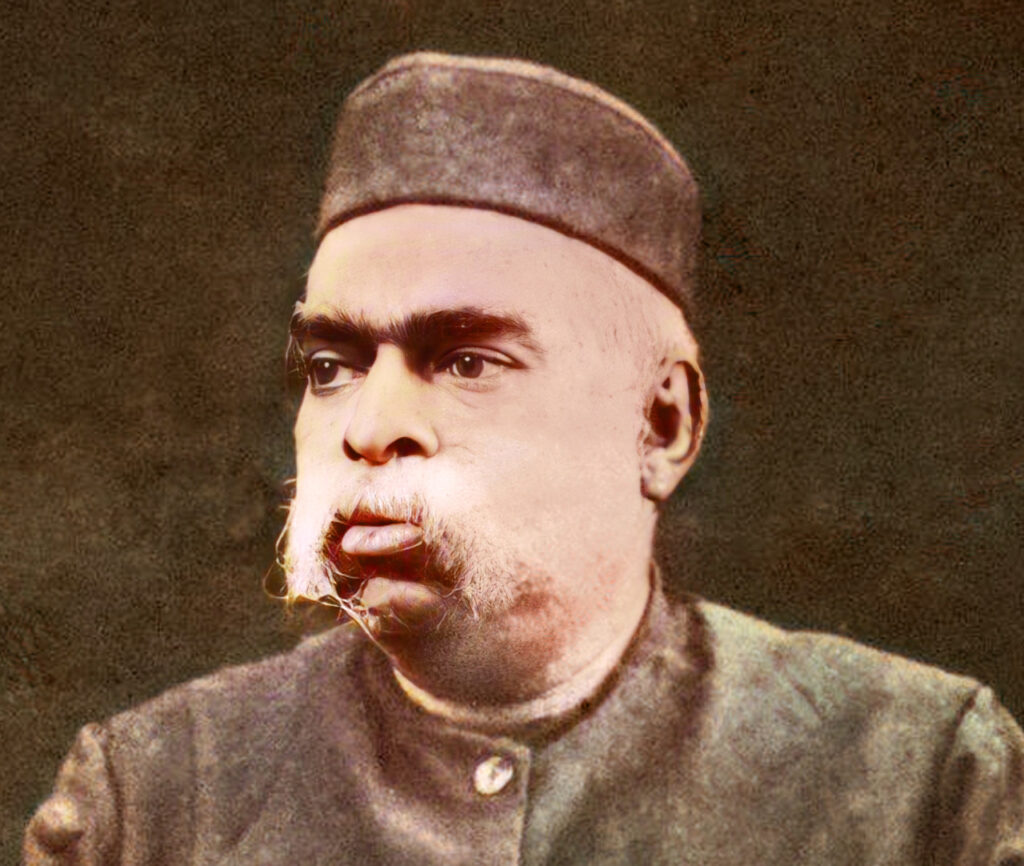
4. Ruined by laziness and sleep, I resist all pious deeds; yet I am very active and enthusiastic to perform wicked acts. For worldly fame and reputation I engage in the practice of deceitfulness. Thus I am destroyed by my own greed and am always lustful.
5. A vile, wicked man such as this, rejected by godly people, is a constant offender. I am such a person, devoid of all good works, forever inclined toward evil, worn out and wasted by various miseries.
6. Now in old age, deprived of all means of success, humbled and poor, Bhaktivinoda submits his tale of grief at the feet of the Supreme Lord.
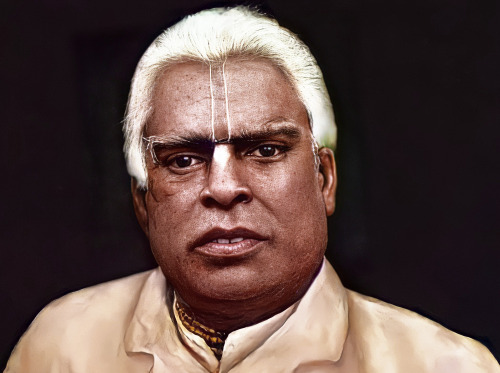
It is clear from these themes, that aside from personally feeling a state of profound humility, Srila Bhaktisiddhanta Sarasvati Thakur was discussing the giving up of pride and envy, the weeds that choke the creeper of devotion. The above verses were a profound instruction and warning to his disciples about how to cultivate bhakti with great humility themselves. He was aware of the fire of ordeal that was to come for them collectively and individually. Therefore, he identified the dangerous impediments to spiritual advancement (anarthas) and explained how to remove them without falling prey to arrogance or envy of others. The great acharya, who was now soon to depart this world, was giving essential instructions about the pitfalls that would ensnare many of his disciples.
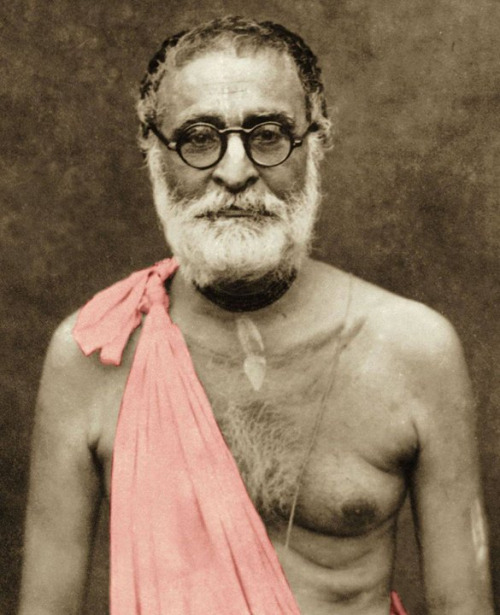
This is reminiscent of Srila Bhaktivedanta Swami Prabhupad’s last days, when he gave his disciples many warnings about cooperation and not allowing themselves to be motivated by false prestige, pride and worldly ambitions. Similarly, he exhibited extreme humility, asking his God-brothers to forgive him for his offenses, feeling that he had been proud, etc. And we see how apt and crucially important these warnings by the self-realized acharyas are, for having personally transcended such petty problems of heart, they can clearly see the absolute necessity to warn their disciples about these stumbling blocks on the path of bhakti, both by their words and their deeds.
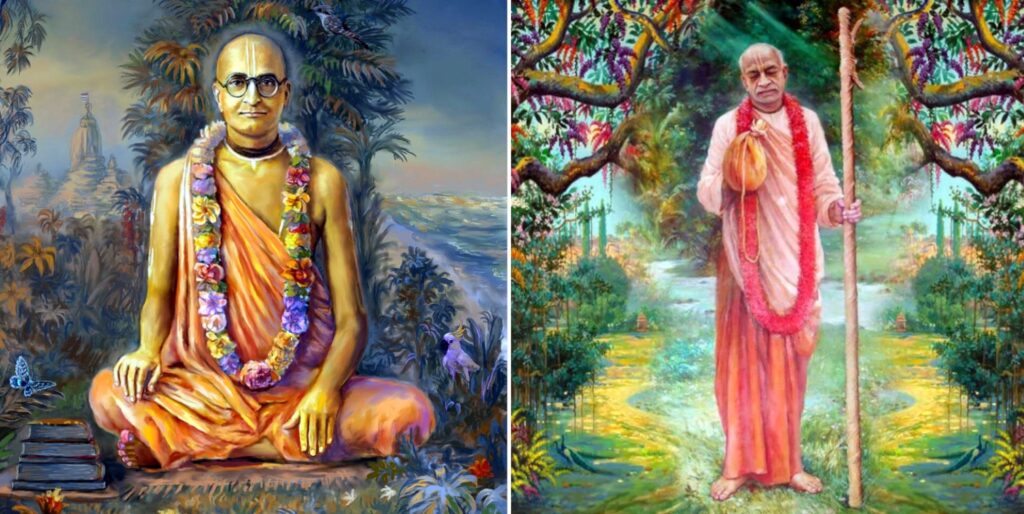
Srila Bhaktisiddhanta Sarasvati Thakur had also elaborated on these themes in Dacca during the previous year (1935):
Look within. Amend yourself, rather than pry into the frailties of others.
In this world of Maya, averse to the Lord, full of trials and tribulations, only patience, humility and respect for others are our friends for Hari bhajan.
The Lord Gaurasundar puts His devotees in various difficulties and associations to test their patience and strength of mind. Success depends on their good fortune.
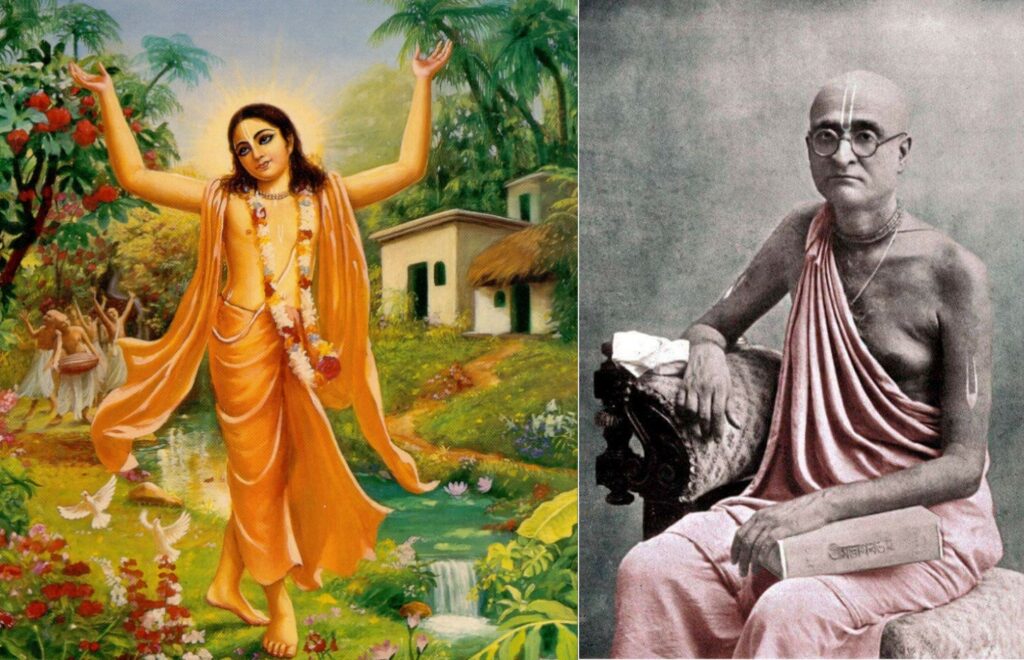
When faults in others misguide and delude you, have patience, introspect, find faults in yourself. Know that others cannot harm you unless you harm yourself.
I wish that every selfless, tender-hearted person of Gaudiya Math will be prepared to shed two hundred gallons of blood for the nourishment of the spiritual corpus of every individual of this world.
Srila Bhaktisiddhanta Sarasvati Thakur gave another long lecture in December of 1936 which centered on the theme of how to deal with an uncontrolled mind. He again referred to the first verse of Manah Siksa (Prayers to the Mind) by Raghunath Das Gosvami:
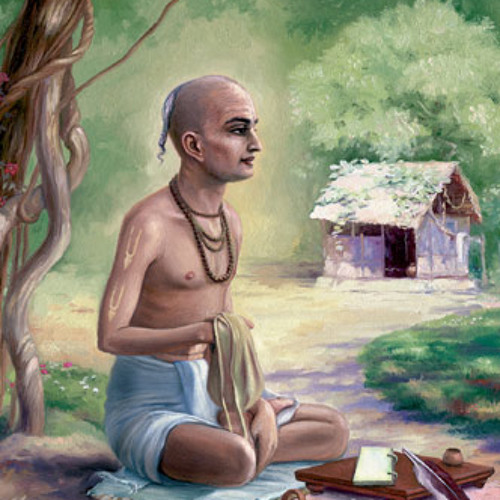
O my dear brother, my foolish mind, taking hold of your feet, I humbly pray to you with sweet words. Please give up all pride and quickly develop deep, loving attachment for the spiritual master, Sri Vrajadhama, the residents of Vraja, the Vaisnavas, the brahmanas, your diksa-mantras, the holy names of the Supreme Lord, and the shelter of Sri Sri Radha-Krishna, the eternally youthful Divine Couple of Vraja.
He also referred to Srila Bhaktivinoda Thakur’s song from the Gitavali under the topic of sreyo-nirnaya (spiritual welfare). He explained the song in some detail, especially the first verse which translates as:
O my mind, how wicked and foolish you are. Just worship the lotus feet of Radha and Krishna in the forests of Vraja. Without such worship there is no means of spiritual advancement. Give up all speculative knowledge and materialistic activities and just worship Radha and Krishna in the forests of Vraja.
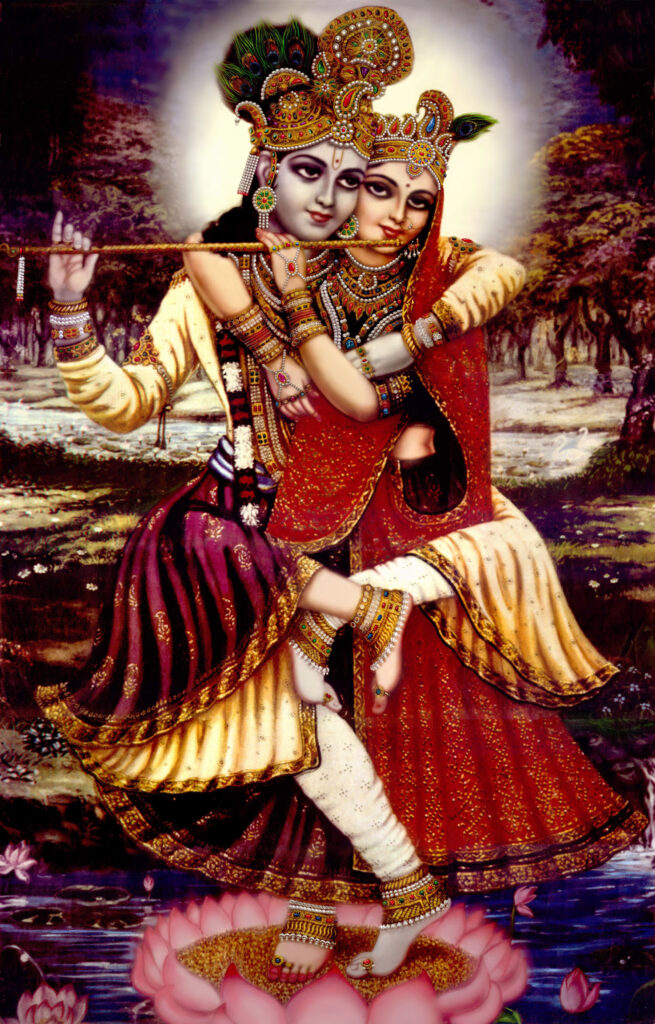
On the 13th day of December, 1936 at the Gaudiya Math’s Auditory Hall, Srila Bhaktisiddhanta Sarasvati Thakur gave a very long lecture in which he covered a wide range of topics, touching again and again on the theme of the danger of worldliness encroaching on one’s spiritual endeavours. He quoted a song he had written called Nirjana Anartha, translated as:
Your gold is the progenitor of enjoyment – serve Madhava with gold. The desire in your heart for beautiful women is not for you – their only proprietor is Yadava (Krishna). The tree of desire for fame is the desert of the illusory energy. Ravana did not get it by struggling against Raghava (Lord Rama). Be dedicated to the fame of a Vaisnava. If you do not worship that, you will go to hell (raurava).
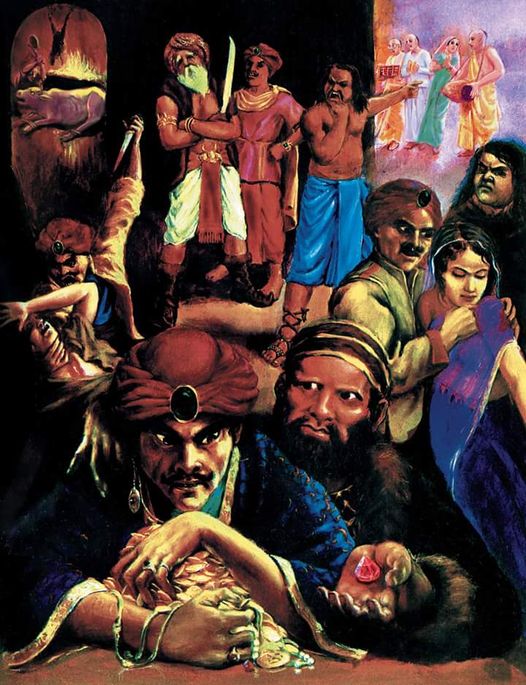
In the Fifth Canto of Srimad-Bhagavatam, the type of person who spends time on the hellish planet called Raurava is described as follows:
A person who accepts his body as his self works very hard day and night for money to maintain his own body and the bodies of his wife and children. While working to maintain himself and his family, he may commit violence against other living entities. Such a person is forced to give up his body and his family at the time of death, when he suffers reaction for his envy of other creatures by being thrown into the hell called Raurava.
[Srimad Bhagavatam 5:26:10]
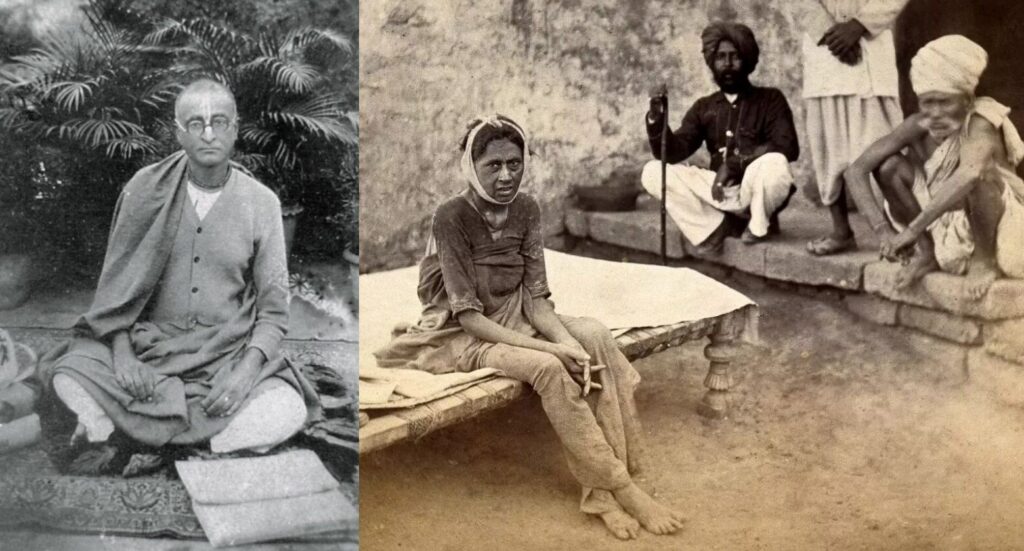
Again the theme of ridding oneself of anarthas (impediments to spiritual advancement) was strongly being preached by Srila Bhaktisiddhanta Sarasvati Thakur. In a mood of deep compassion, he was urging everyone to give up pride and envy and simply immerse themselves in spreading the glories of the Lord. This was his mission and he quoted multiple sources to encourage single-minded devotion to Krishna. Finally, he concluded:
We are all sojourners (temporary residents) on the path of death. Everyone has to die; therefore, in this state of life whether one is male or female, high or low, king or subject, rich or poor, learned or foolish – everyone can make this very rare human form of life successful by becoming a servant of the servant of the eternally pure, completely blissful Sri Hari. Even in this conditioned life one can become liberated. Therefore, it is overwhelmingly necessary to try …
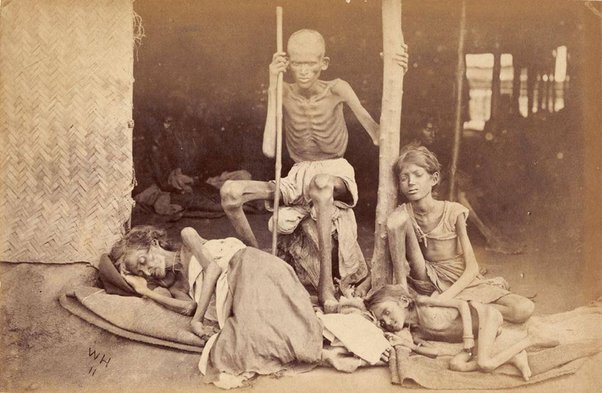
On December 23rd, eight days before entering the eternal pastimes of the Lord, he made the following remarks:
I have given anxiety to many people, as I have been compelled to speak genuinely truthful words, and as I have told people to worship Hari without any hypocrisy. There are possibly many people who even consider me to be an enemy. So that they may become eager to perform the sincere service of Sri Krishna, freed from other desires and deceitfulness, I have given various types of anxieties to numerous people. One day or another they will certainly be able to understand this.
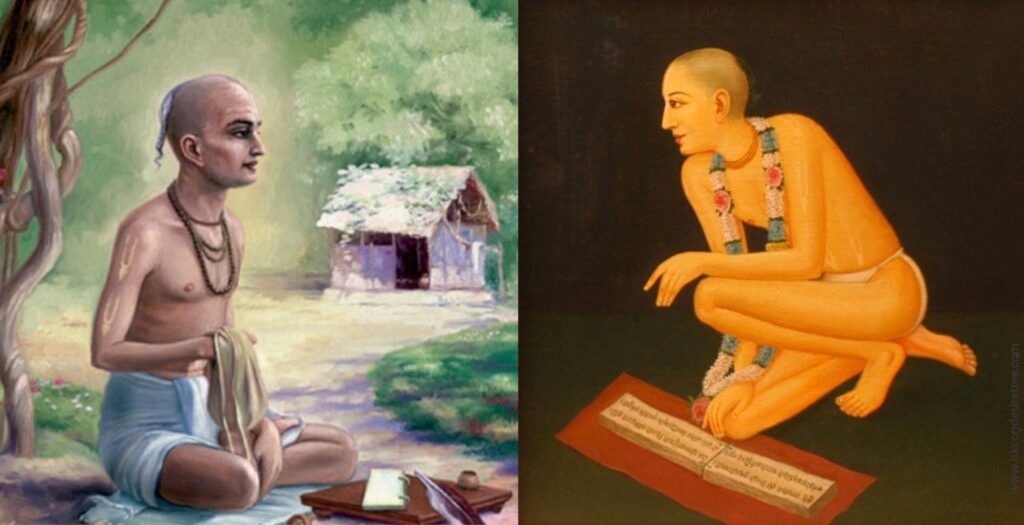
Srila Raghunath Das Goswami and Srila Rupa Goswami
With great enthusiasm preach the words of Sri Rupa and Raghunath to everyone. Our ultimately desirable object is to become the dust at the lotus feet of the followers of Sri Rupa. All of you remain united in allegiance to the Asraya-vigraha (the form in whom we can take shelter – the spiritual master) in order to satisfy the senses of the Transcendental Entity of Non-Dual Knowledge. Everyone, with the sole view of worshipping Hari, will carry on life in this temporary, two-day material existence in any way possible.
Do not give up the worship of Hari even amidst hundreds of dangers, hundreds of insults or hundreds of persecutions. Do not become unenthusiastic upon seeing that the majority of people in this world are not accepting the message of Krishna’s sincere worship. Never give up the audition and glorification of the topics of Krishna. They are your own personal worship and your very all and all. Being humble like a blade of grass and patient like a tree, constantly glorify Hari.
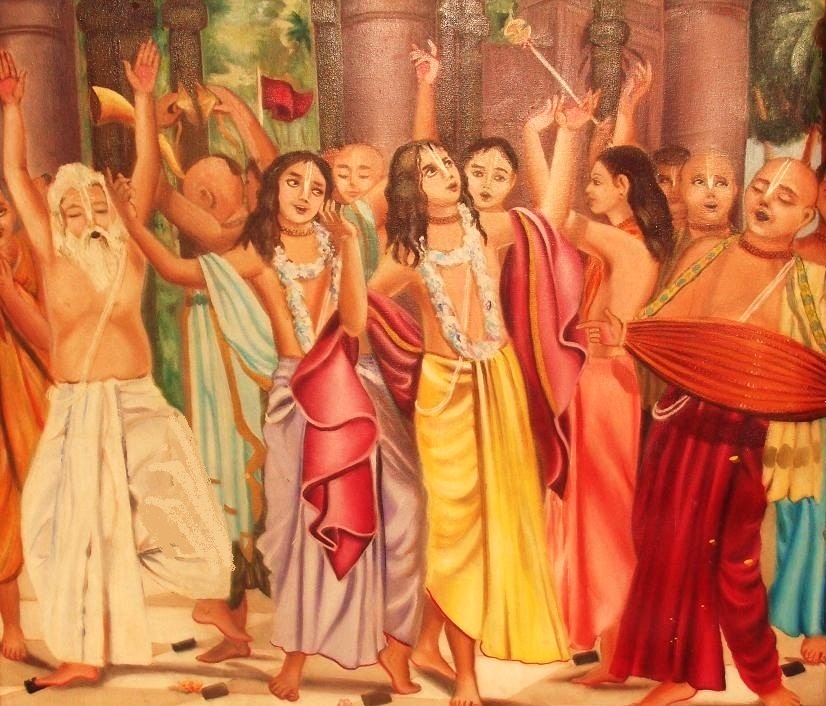
We are nurturing a desire to dedicate this good-for-nothing body in the samkirtan-sacrifice of Sri Krishna Chaitanya and His associates. We are not at all desirous of any heroism in fruitive actions or religion, but our real condition is to be the dust at the lotus feet of Sri Rupa Prabhu birth after birth – this is our all and all. The line of Bhaktivinoda will never be closed. With even more enthusiasm you should become engaged in preaching the desire of Bhaktivinoda’s heart. Amongst you there are many capable and accomplished men. We have no other desire at all, these are our only words:
Taking a blade of grass between my teeth I fall down and again and again pray that I may become the dust at the feet of Srimad Rupa birth after birth.
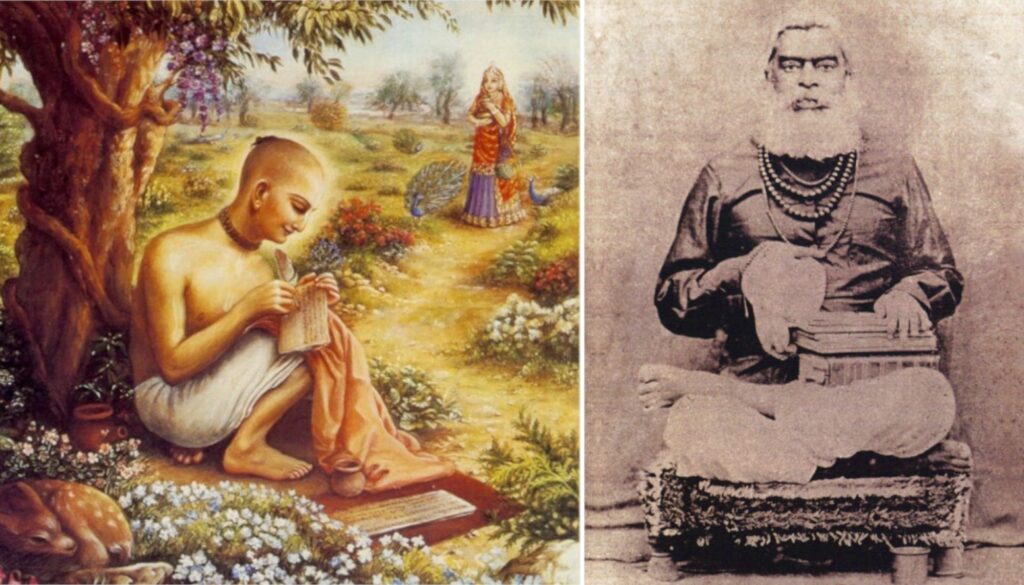
There are various types of inconveniences while staying in this world, but there is no need for us to become extremely afflicted by these inconveniences or to try to dispel these inconveniences. While staying here it is necessary for us to gain an introduction to what our eternal life will be and to what Entity we will attain to after all these inconveniences have been removed. Here, it is compulsory to make decisions about all those objects which attract and repel us in various ways – both that which I want and do not want. We will be drawn by the attractions and repulsions of this place to the same degree as the amount of intervening distance there is between us and the lotus feet of Krishna.
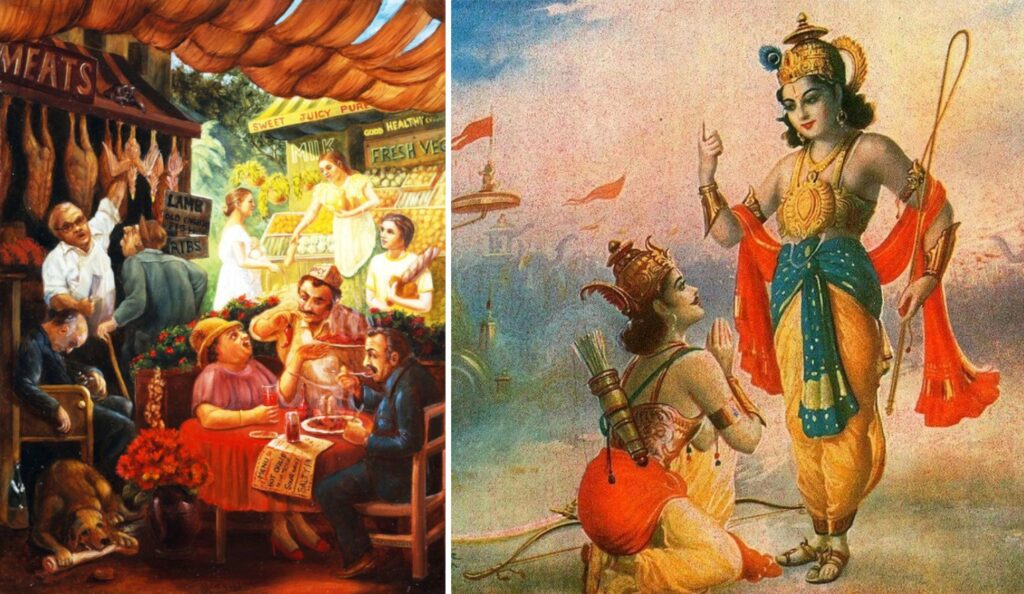
When we go beyond the attractions and repulsions of this world and are attracted by the Transcendental Name, then the topics about the mellow of service to Krishna (our rasa or flavour of relationship) can be understood. At the present time the topics about Krishna are greatly startling and perplexing. Adventitious occurrences are obstructing our eternally needed realization. To eliminate these, everyone who holds the name of a human being is more or less consciously or unconsciously engaged in a struggle. To enter into that eternally needed kingdom beyond all duality is our only necessity.
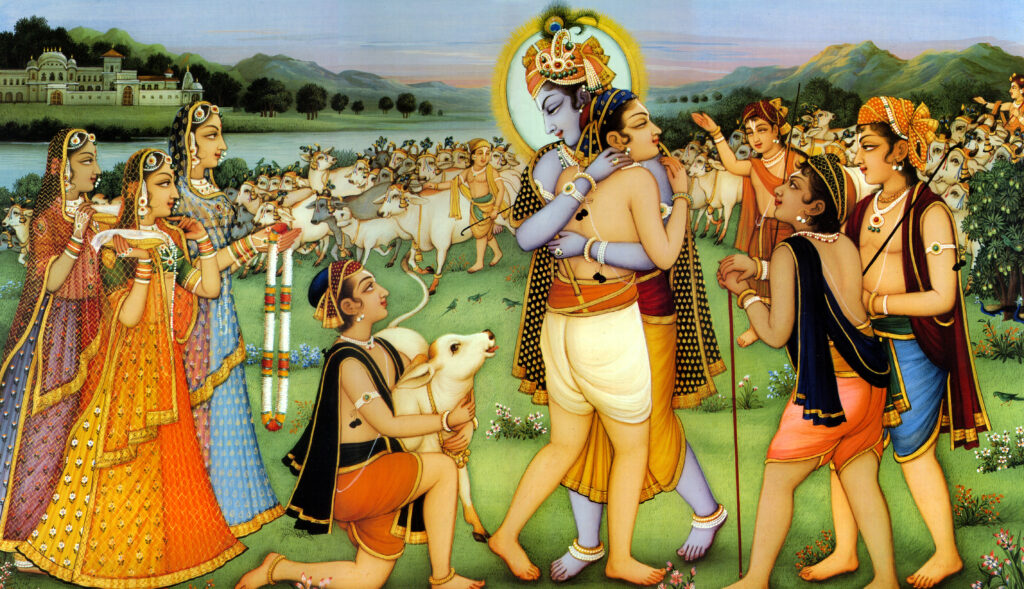
We have no (lasting) attachment or detachment to anybody in this world. All the arrangements of this world are momentary. That supreme desideratum is indispensably necessary for every single person. May all of you, with one aim and in a single voice, attain the right of serving the original Asraya-vigraha (the form of the Lord Who gives us shelter). May the flow of thought of Sri Rupa’s followers stream over the world. May we never, in any condition whatsoever, show aversion to the sacrifice of chanting the *seven-tongued sankirtan of Sri Krishna. If there is ever increasing attachment for this, perfection on all sides will be achieved. May all of you, by the earnest pursuance of Sri Rupa’s followers, preach the words of Sri Rupa-Raghunath in a fearless voice with supreme enthusiasm.
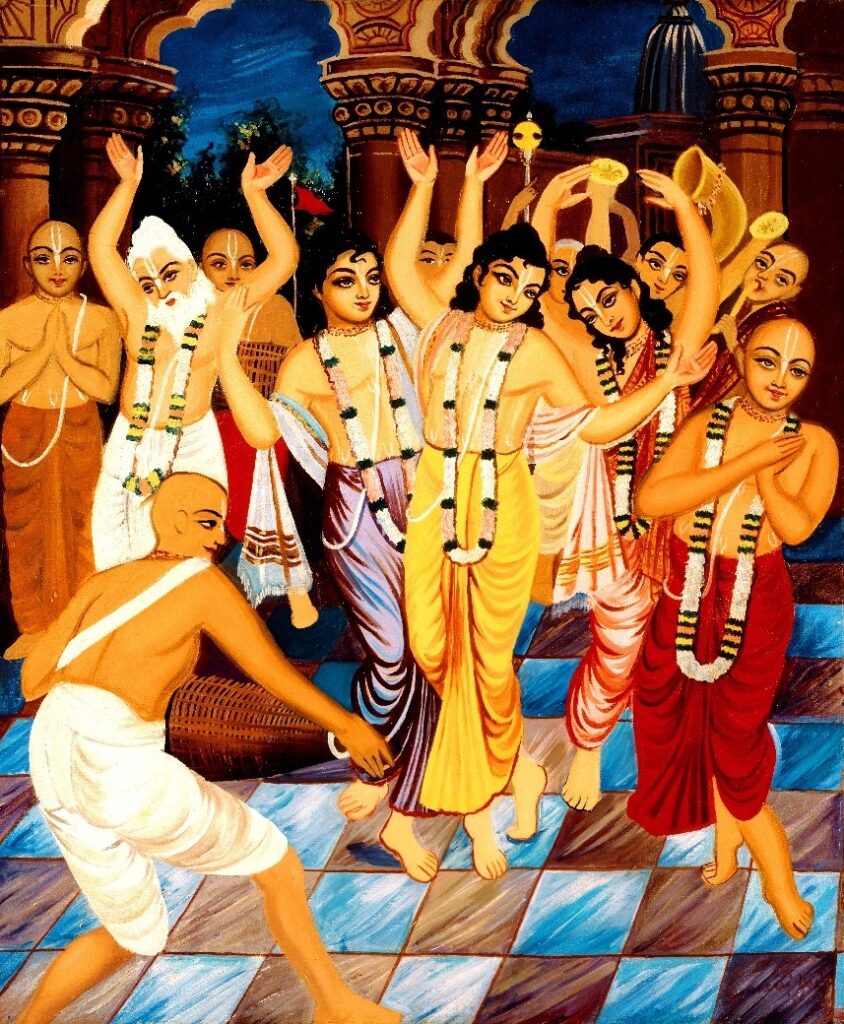
*The seven-tongued sankirtan of Sri Krishna was explained by Srila Bhaktisiddhanta Sarasvati in 1932 in a lecture titled Vijayate Sri Krishna Sankirtanam. I have included some extracts below. Srila Bhaktisiddhanta Sarasvati begins by quoting a translation of the first verse of Lord Chaitanya’s Sikshastakam Prayers:
Supreme victory to the chanting of the holy name of Sri Krishna, which cleanses the mirror of the heart and completely extinguishes the blazing forest fire of material existence, and which spreads the moon rays of bhava and causes the white lotus of good fortune for the jivas to bloom. The holy name is the life and soul of transcendental knowledge, which is herein compared to a wife. It continuously enhances the ocean of transcendental bliss, enabling one to relish total nectar at every step and thoroughly cleanses and cools everything, internal and external, including one’s body, heart, self (atma) and nature.
[Sri Sikshastakam 1]
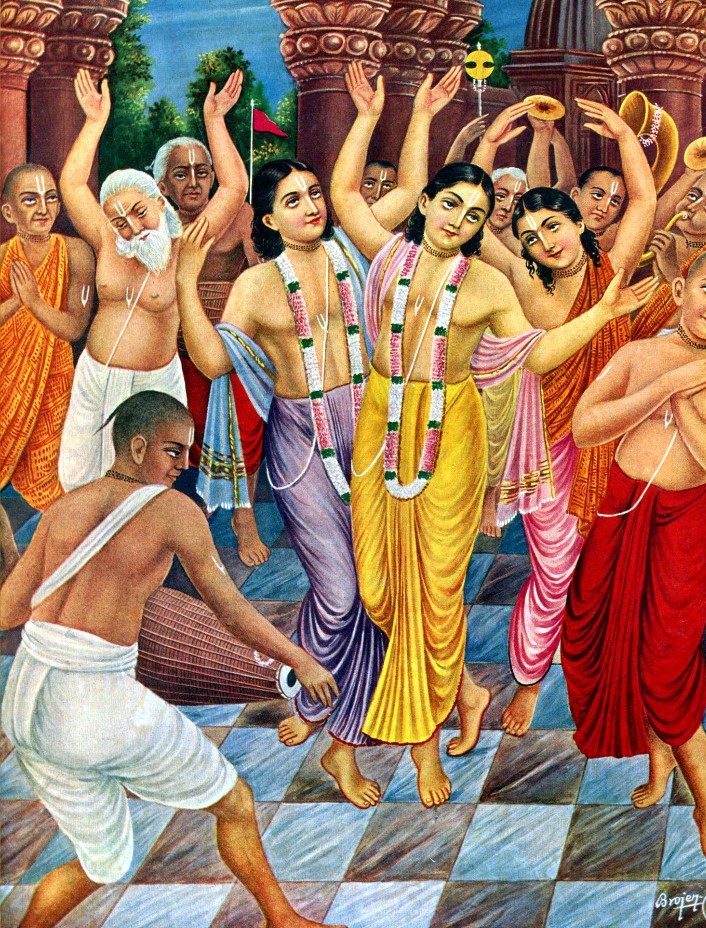
The Vedic scriptures describe fire as having seven “tongues” (of flame), each of a different colour according to its intensity. The colours of these tongues are blackish (karaali); deep smoky purple (dhumina); white (shweta); red (lohita); golden (swarna) and reddish pink like a lotus (padmaraaga). In the same way, Sri Gaursundar has sung the glories of the fire of sankirtan, which also has seven tongues. … Unless the fire of sankirtan is kindled and blazes, one’s (attachment to) material existence will not be removed by the root, and salvation’s topmost goal, prema, will never be achieved.
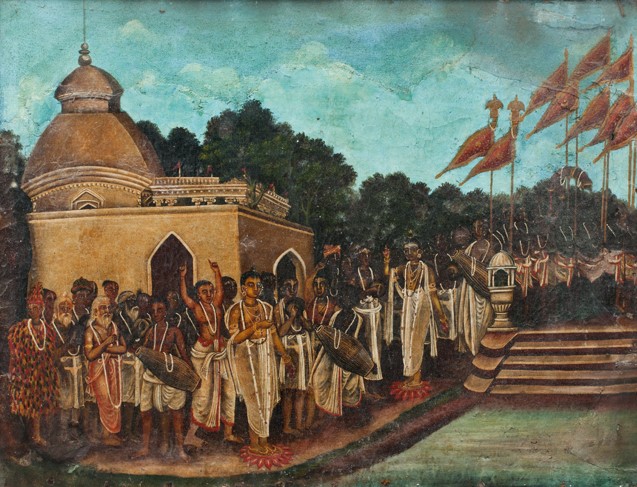
Sri Gaurhari describes the fire of sankirtan’s seven tongues using seven similes. He likens (1) the heart to a mirror; (2) material existence to a great forest fire; (3) spiritual welfare to moonlight or the brightness of the moon; (4) knowledge to a bride, (5) bliss to the ocean, (6) prema to ambrosia and (7) the attainment of service to Sri Krishna to a spiritual bath in which one fully immerses onself. The adverb prati-padam (at every step) is used before each of these seven adjectives, which define sankirtan. The fire of Sri Krishna sankirtan will achieve topmost victory by burning to ashes and engulfing every desire other than the desire to serve Sri Krishna. This includes all possible desire for the results of fruitive activities, of developing speculative knowledge and mystic powers; of strictly observing vows and of performing austerities.
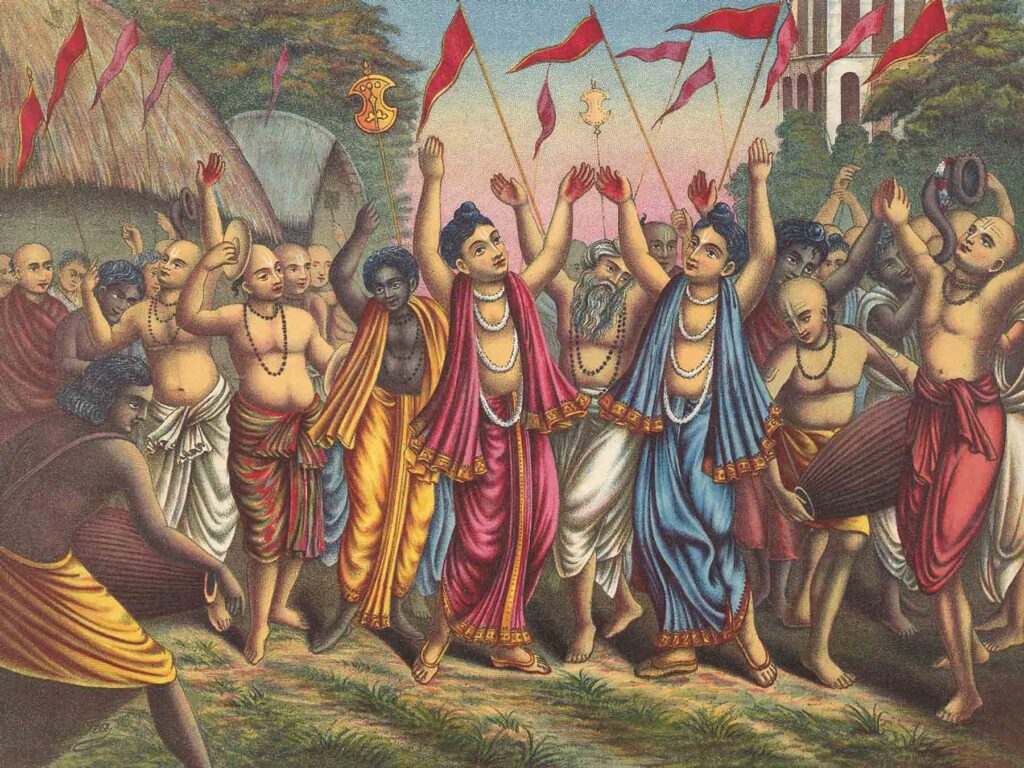
Anyone of good intelligence in the past, present or future can realise the most exalted victory of Sri Krishna Chaitanya sankirtan, no matter where in this world he is born. Less intelligent persons engage in other practices to attain other goals. Those who are intelligent engage in the yagna (sacrifice) of sankirtan to worship with love that great personality of fair complexion whose radiance is the colour of molten gold. … May the fire of the sankirtan yagna, which is adorned with seven tongues and kindled by highly intelligent persons, continually remain alight in Sri Chaitanya Matha.
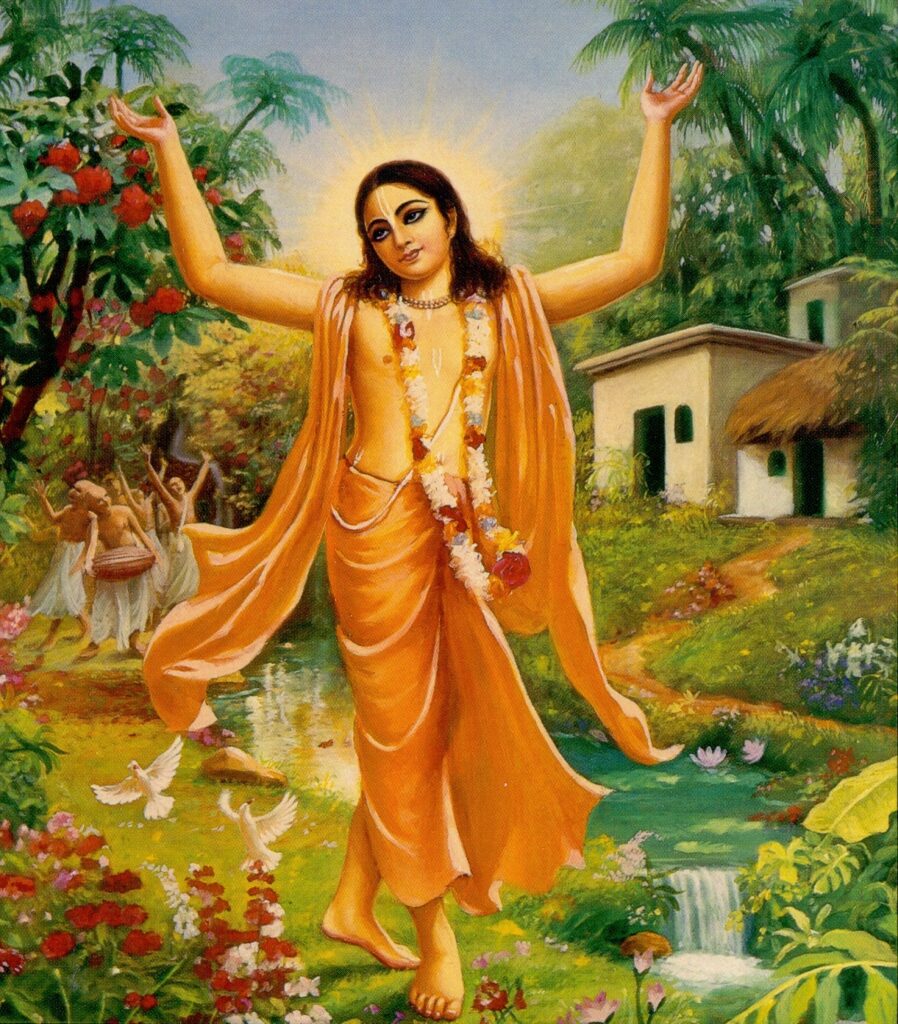
Sri Krishna Chaitanya sankirtan authomatically achieves everything that is accomplished by performing intense meditation (maha dhyana) in Satya Yuga; grand and elaborate sacrifices (maha yagna) in Treta Yuga and opulent deity worship (maha archana) in Dwapara Yuga. In Satya yuga, when religion stood on all four legs (austerity, cleanliness, mercy and truthfulness), only meditation was performed. In Treta yuga, when religion stood on three legs (cleanliness, mercy and truthfulness), only sacrifice was performed. In Dwapara yuga, when religious principles stood on two legs (mercy and truthfulness), only deity worship was performed. But in Kali yuga (when religion stands only one one leg – truthfulness), the source of all incarnations Sri Gaursundar, appears and delivers the people by manifesting sankirtan. He thus gives a person the opportunity to simultaneously perform intense meditation, magnificent sacrifice and opulent worship of the deity – through one simple activity.
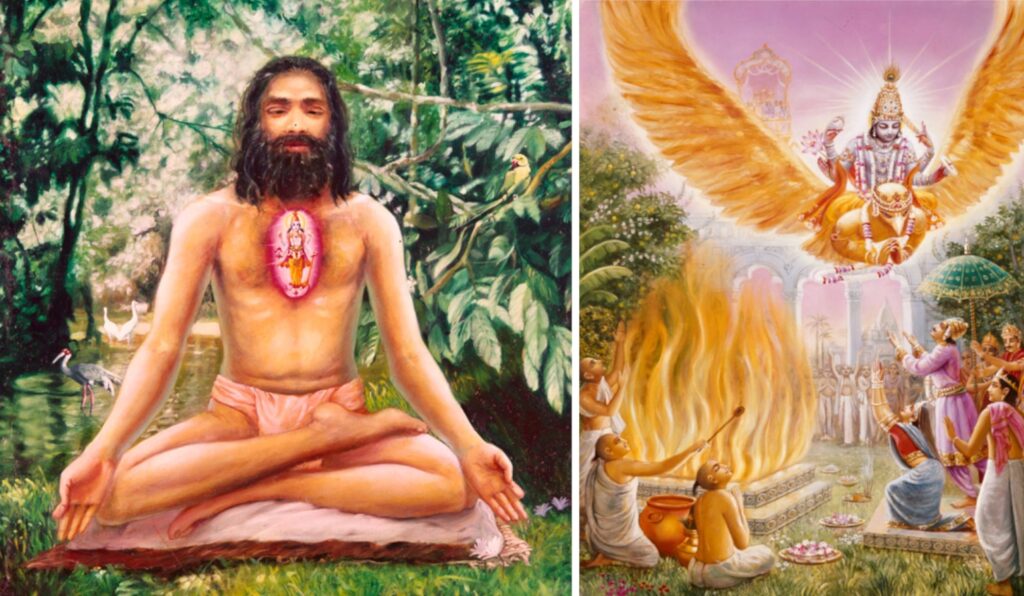
Yuga dharmas for Satya yuga – meditation on Lord Paramatma and Treta yuga – elaborate sacrifices
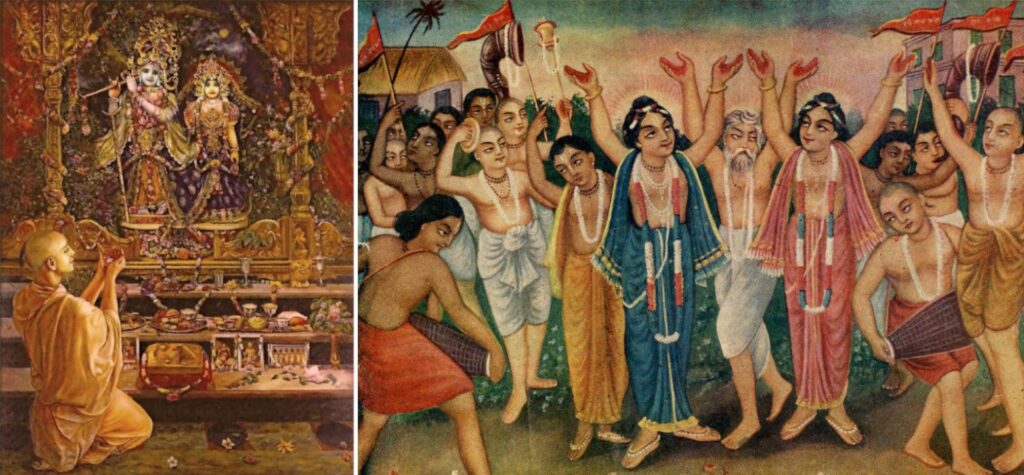
Yuga dharmas for Dwapara yuga – opulent deity worship and Kali yuga sankirtan chanting
One cannot serve the combined form of Sri Radha-Govinda (i.e. Mahaprabhu), by any means other than sankirtan. Nor can one serve Sri Radha-Govinda simply by performing archana (deity worship). They can be served only by maha archana, that is, sankirtan. In the same way, the gopis cannot be satisfied by the yogis’ practice of meditation. Meditation is appropriate in relation to a remote entity, who is hidden and beyond reach; it is inappropriate in relation to a person who has been easily and completely made one’s own, and whom one holds in constant embrace.
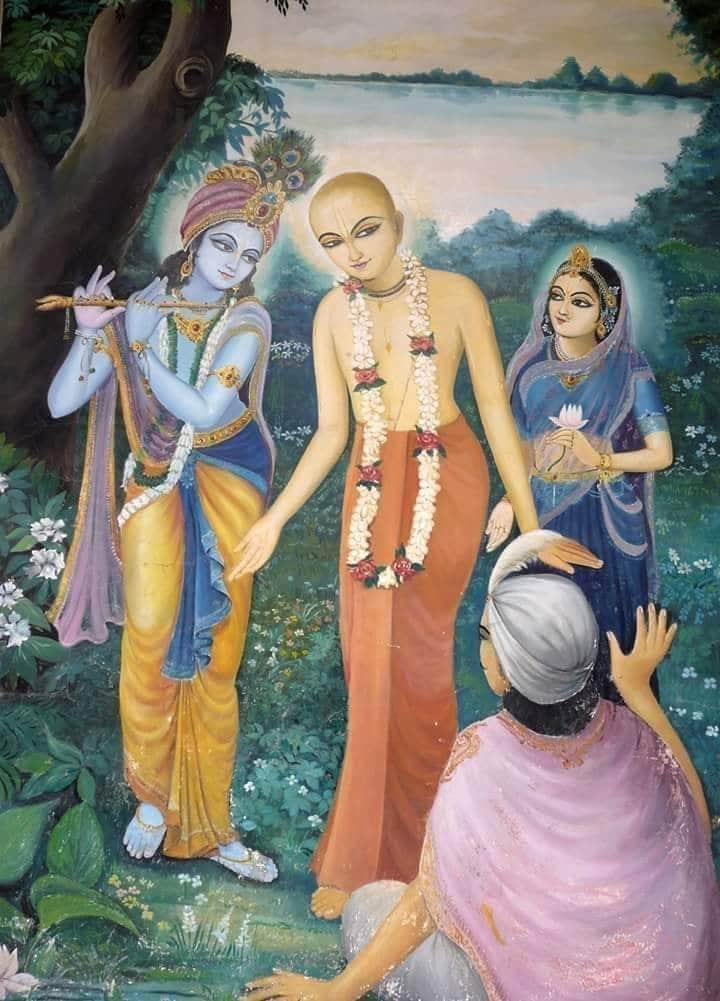
Lord Chaitanya is Radha and Krishna combined
Krishna appeared towards the end of the Dwapara yuga and projecting Himself as the object of devotion, personally spoke such words as: “surrender only unto me” and “I alone am the enjoyer and master of all sacrifices.” But as the darkness and intoxication of atheism became prominent, the multitude of souls, who were driven by demonic intelligence, thought that the autocrat Purushottam, the Supreme Personality of Godhead Sri Krishna, had spoken these words out of ego and pride. Thus they deviated from the path of spiritual welfare. No one in the present age would care to listen to Sri Krishna’s words if He simply appeared again in the same form. It was essential that He appear combined with Sri Vrishabhanu-nandini (the daughter of Vrishabhanu – Radharani) and thereby avoid the perception of the public that He is autocratic.
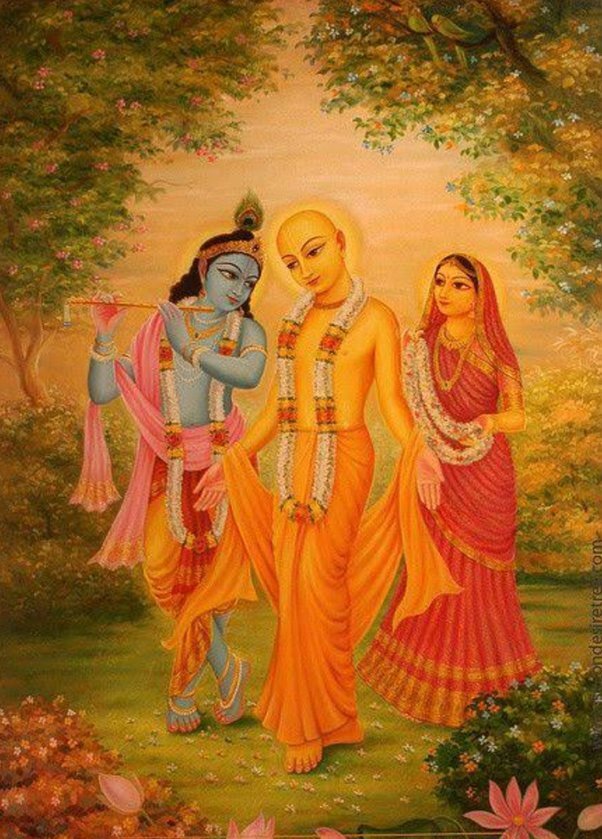
Let the celebrations on the eve of the appearance of the combined form of Sri Radha-Madhava be accomplished by means of sankirtan, the congregational chanting of the holy names. Let all other conceptions be reduced to ashes in the fire of sankirtan. May the consciousness of all living beings become fuel in the fire of love for Krishna (Krishna kamaagni), in the fire of service to His holy names (Krishna namaagni) and in the fire of service to His divine abode (Krishna dhamaagni). Ganga devi has achieved oneness with Sri Yamuna Maharani by the influence of the appearance of Gaursundar, who is non-different from Vrajendra-nandana (Krishna). Upon her banks, the secret amorous pastimes of Radha and Madhava combined – that is, sankirtan-rasa – be victorious!
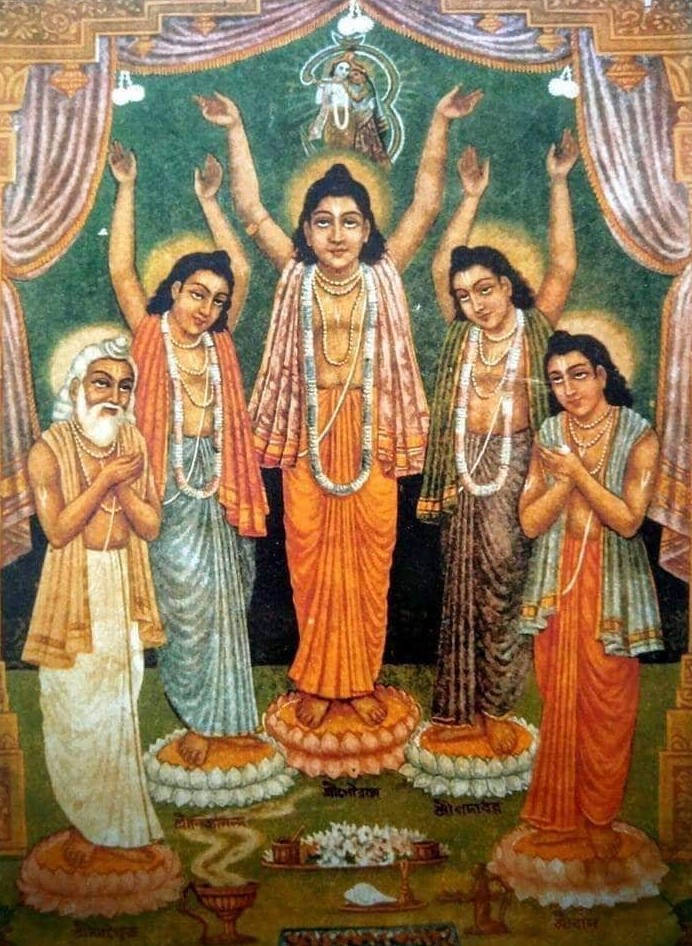
The Disappearance of Srila Bhaktisiddhanta Sarasvati Thakur
On the morning of December 31, 1936, Srila Bhaktisiddhanta Sarasvati Thakur requested a couple of his disciples to sing Sri Rupa Manjari by Srila Narottam Das Thakur and the Sikshastaka Prayers. In the forenoon he requested the editor of the Gaudiya magazine to see to it that the Vaisnava Manjusha (Casket of Vaisnava Vocabulary) would be compiled and published. In his last days he had specifically requested that his disciples form a Governing Body Commission (GBC) of 10 or 12 devotees to manage the Society’s affairs. To all he announced:
Please accept my blessings to you all, present and absent. Please bear in mind our sole duty and religion is to spread and propagate service to the Lord and His devotees.
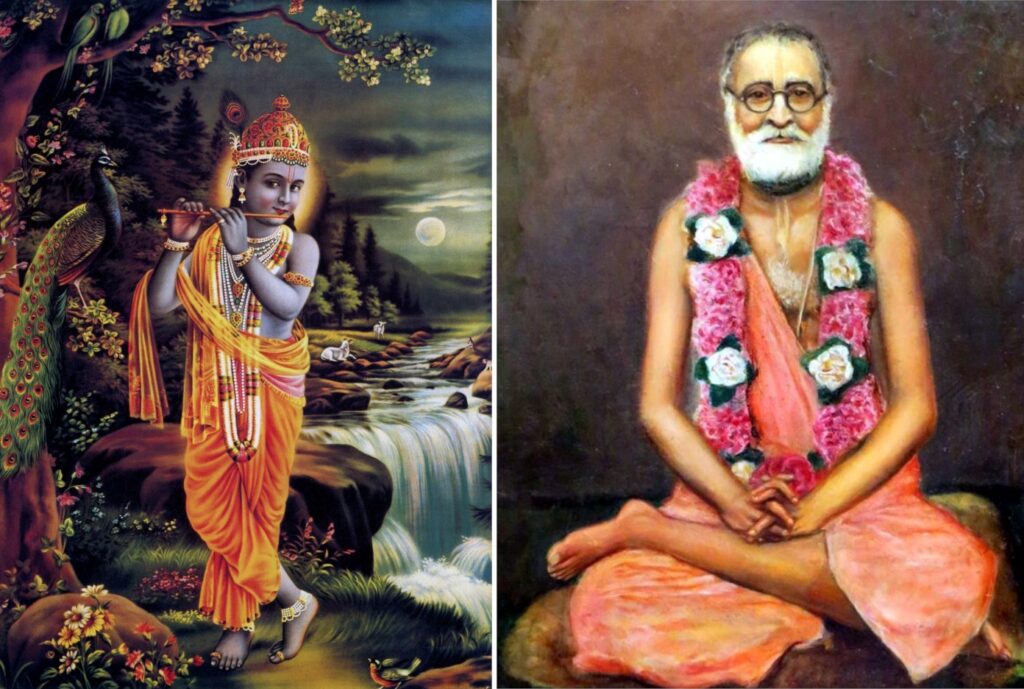
Thus, the great acarya, the simha (lion) guru, the uncompromising sadhu, the tireless preacher of the pure teachings of Sri Chaitanya Mahaprabhu, left this material world uttering the name of Krishna at about 5:30 in the morning of January 1st, 1937. This great “Vaikuntha man” as Srila Bhaktivedanta Swami once described him, entered the pastimes of the Supreme Lord, having firmly established the foundation of a spiritual movement, which would be carried around the world by his pure servant, His Divine Grace A.C. Bhaktivedanta Swami Prabhupad.
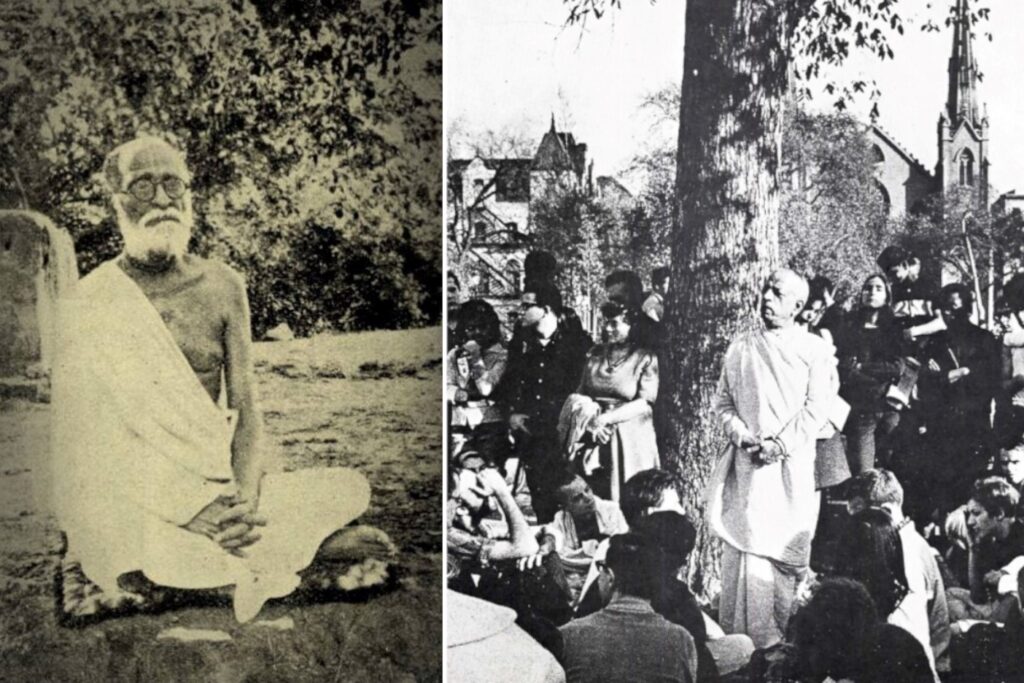
Last photo taken of Srila Bhaktisiddhanta Sarasvati Thakur and Srila Bhaktivedanta Swami kicks off the Sankirtan movement in the Western world at Tompkins Square Park in New York city
After Srila Bhaktisiddhanta Sarasvati Gosvami Maharaja’s disappearance, his transcendental body was worshipped with scented oil, flowers and sandalwood paste. Then his spiritualised body was brought before the Deities in the Sri Sarasvata Auditory Hall and decorated with flowers, garlands and cloth. There the appropriate worship and arati was performed. After this, an immense sankirtan procession carried the divine form to Sealdah Railway Station. Along the way, thousands had a final darsan.

Thousands of people came to honour Srila Bhaktisiddhanta Sarasvati as his body was taken by train from Calcutta to Krishnanagar in Nadia
From Krishnanagar he was moved by motor car to Svarupganj and carried with a sankirtan procession to Sridham Mayapur. A huge crowd of devotees and onlookers had gathered, and there was an immense outpouring of grief and separation, but simultaneously a constant glorification of the holy name of Krishna. First, Srila Bhaktisiddhanta Sarasvati Thakur was brought to the Yogapitha, then to Srivasangana, and then to Sri Advaita Bhavana. Finally, he was brought to Sri Vrajapattana, the place of his intense bhajan where he had performed the vow of chanting a billion names of the Lord.
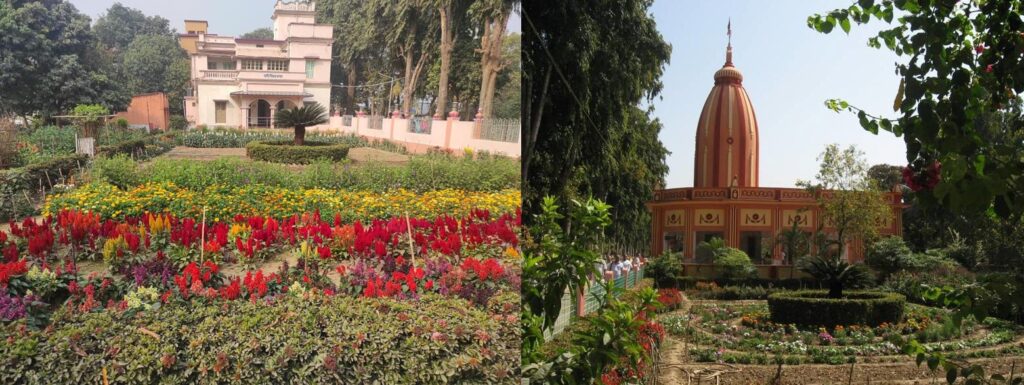
Srila Sarasvati’s Samadhi Temple at Vrajapattana in Mayapur
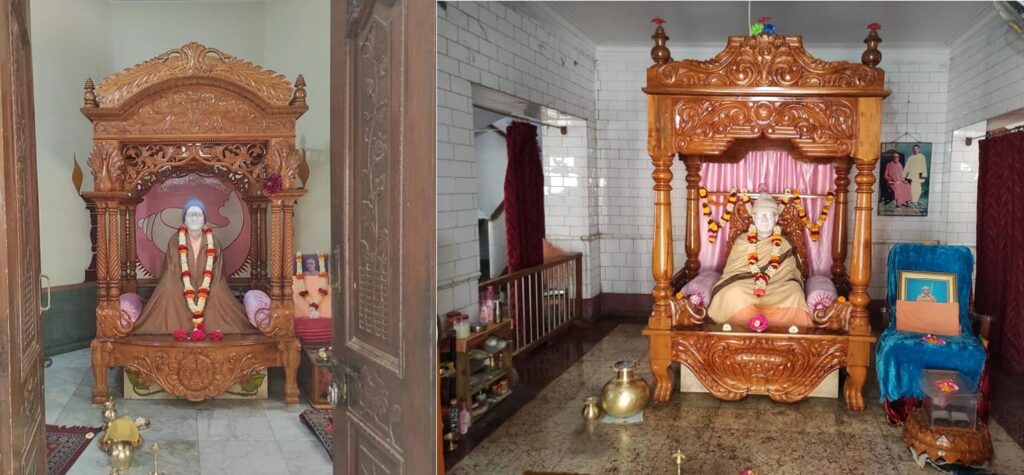
Deities of Srila Sarasvati Thakur in the acharya’s Samadhi Temple at Vrajapattana in Mayapur
He was taken to the front of the samadhi tomb of Srila Gaurakisora Das Babaji Maharaja at Vrajapattana and then to the Sri Avidyaharana Natya Mandira where tremendous kirtan was held for the whole night. The work on the samadhi was immediately begun by sannyasis, babajis, brahmacaris, grhasthas and vanaprasthas who had all taken shelter at his lotus feet. At the end of the night samadhi mantras were written on his body according to the directions of the Samskara Dipika by Srila Gopala Bhatta Gosvami. His spiritual body was then brought to the samadhi site and placed on a throne of white marble. His feet were anointed with aguru and sandalwood paste, and the flowers offered to his feet collected. Flower garlands were offered around his neck, and tulasi plants were sown on all sides.
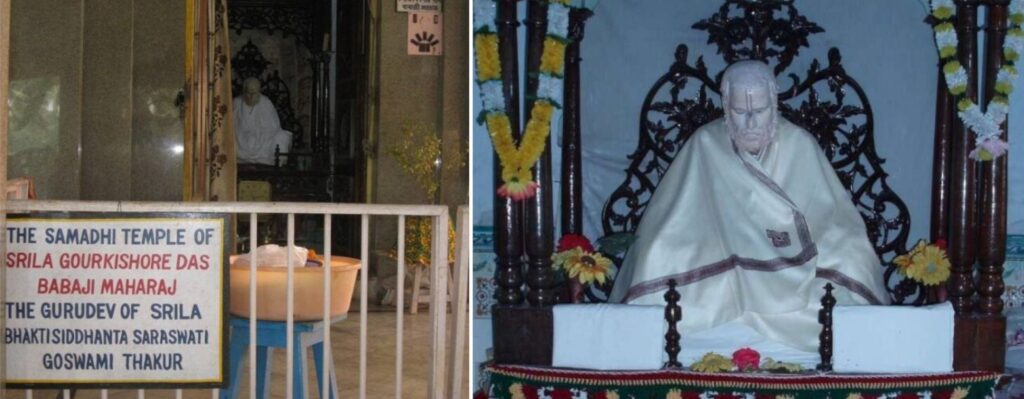
Samadhi Tomb of Srila Gaurakisora Das Babaji Maharaja at Vrajapattana
His favourite songs were sung: Sri Rupa Manjari, Svananda-sukhada-kunja-manohara, and Yasomatinandana. Then, chanting Ye anilo prema dhana, the devotees circumambulated the samadhi site four times. The samadhi was covered with earth and surrounded by tulasi on all four sides, marked with the sign of tilaka and covered with flower garlands. Then a fire sacrifice, offering of bhoga and arati were performed, and there were readings from the Disappearance of Srila Haridas Thakur and Srila Bhaktisiddhanta Sarasvati Thakur’s poems from the end of his Anubhasya. Thus, the “acarya-sun,” as he had been called by his father Srila Bhaktivinoda Thakur, passed from earthly vision, and he entered the eternal pastimes of the Lord.
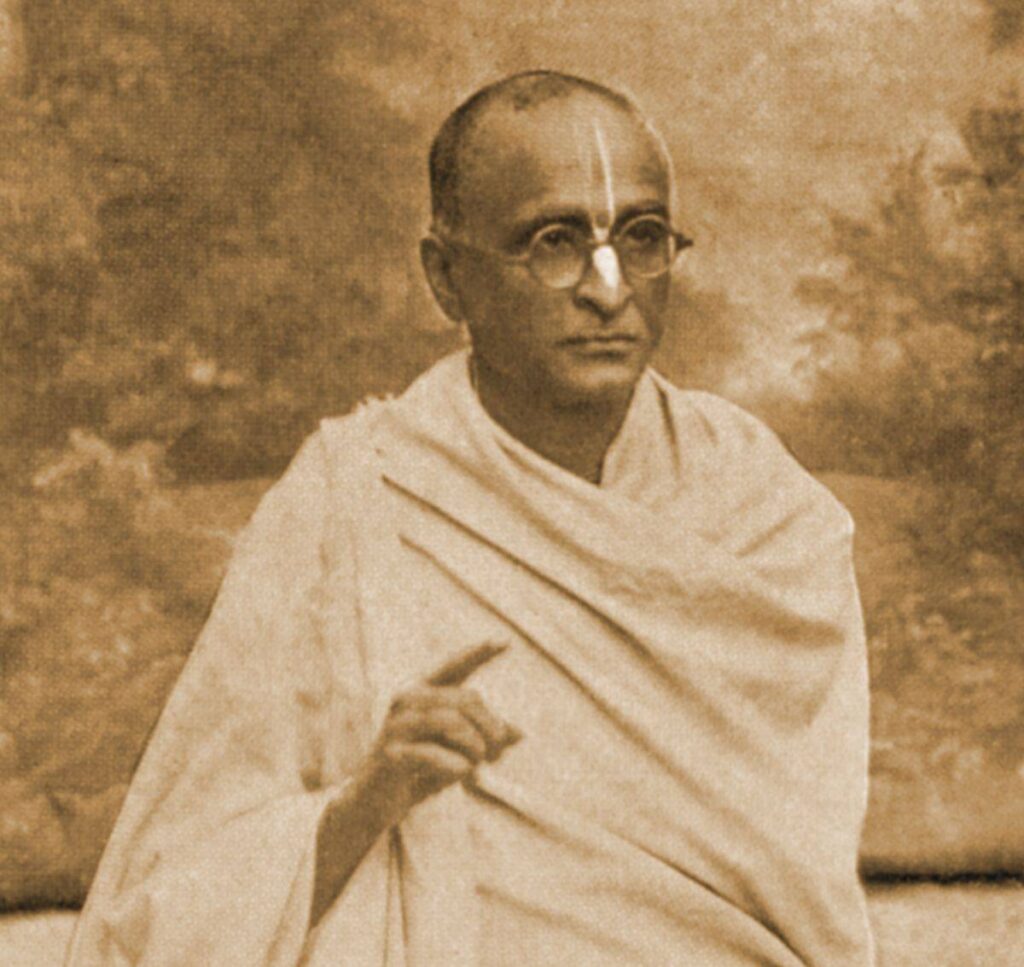
Srila Bhaktisiddhanta Sarasvati’s Contributions Summarized
Bhaktisiddhanta Sarasvati was held in such high esteem among Indian philosophers of his day, that all of the big intellectuals of Calcutta had a memorial gathering upon hearing word of Srila Bhaktisiddhanta Sarasvati’s death. One man, who was an atheist, gave a eulogy and exclaimed:
Who will we argue with now?
Many thousands of years ago, the Padma Purana had predicted the appearance of Srila Bhaktisiddhanta Sarasvati Thakur:
A very elevated, pure and learned personality would appear in Purushottama-ksetra (Jagannath Puri) to spread the glories of Lord Jagannatha all over the world. His activities would be very unique.
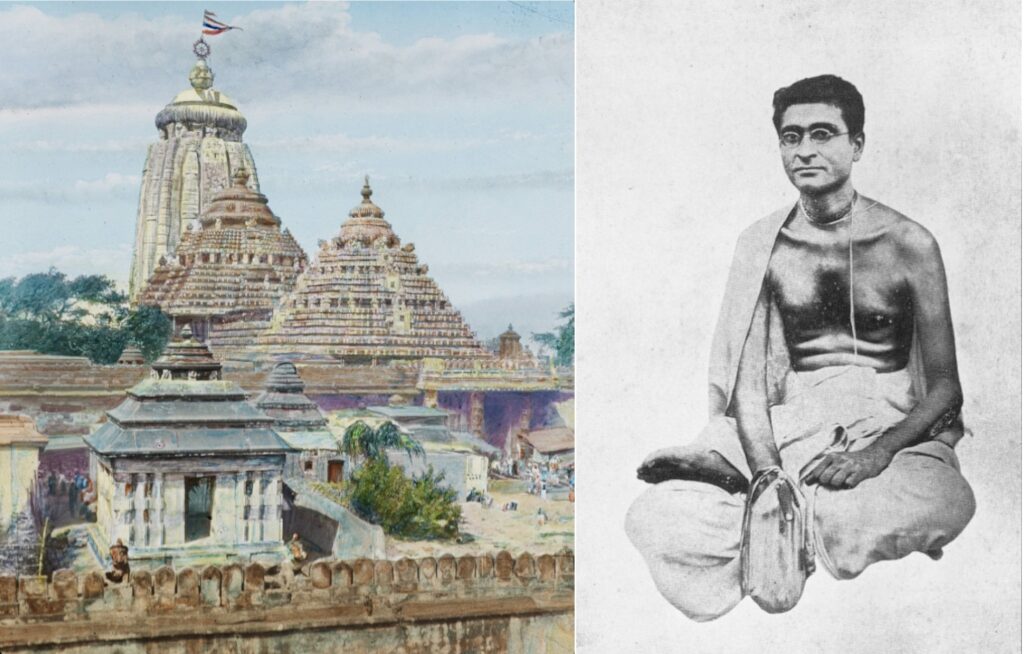
Srila Bhaktisiddhanta Sarasvati Gosvami was in fact one of the most unique and revolutionary preachers in Indian history. He once visited Vrindavan accompanied by a number of disciples dressed in western suits. The reason for doing this was to expose the false renunciates dressed in the garb of babajis, but who secretly indulged in illicit sex, smoked biddi’s (Indian cigarettes), and begged for money as a means of their own livelihood. There was tremendous opposition to Srila Bhaktisiddhanta Sarasvati from the local babaji community, as well as the so-called caste brahmans and caste gosvamis who claimed the title of gosvami or brahman simply by birthright.
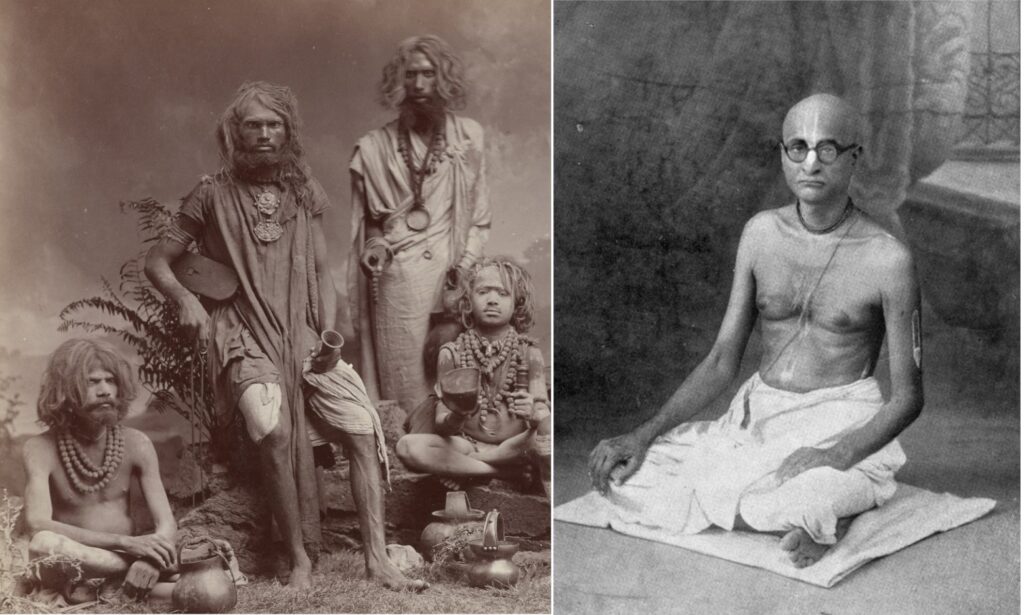
Regardless of the stiff opposition placed before him, Srila Bhaktisiddhanta Sarasvati Thakur continued to preach fearlessly in spreading Lord Chaitanya’s movement, and was known as the “Lion Guru” for his fierce preaching. It is told that many of the well known impersonalist teachers of his day would retreat in fear, crossing the street when they saw the Thakur approaching for fear of being chastised and philosophically embarrassed. His giving the sacred thread to those not born in brahman families created a storm of protest among the caste brahmans and pseudo religionists of his day.
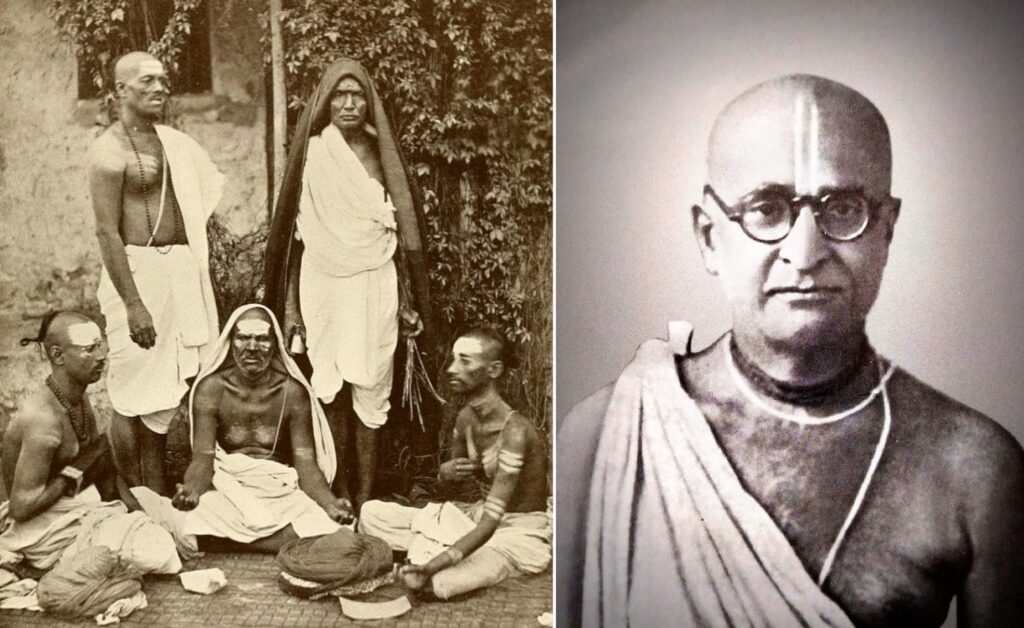
At the time of his passing from this world he had opened 64 Gaudiya Math Temples throughout India, including the large temple at the site of the Yogapitha, which was opened by the King of Tripura in 1935. In all these Maṭhs he established the worship of the arca-vigraha (Deity) form of the Lord. He established Svananda-sukhada-kunja, the bhajan kutir and samadhi tomb of Srila Bhaktivinoda Thakur. Outside of India, temples were established in Rangoon, and small centers in London and Germany. Srila Bhaktisiddhanta Sarasvati Thakur established many presses and printed thousands of books. In 1928 he even established a daily newspaper called the Nadia Prakash.
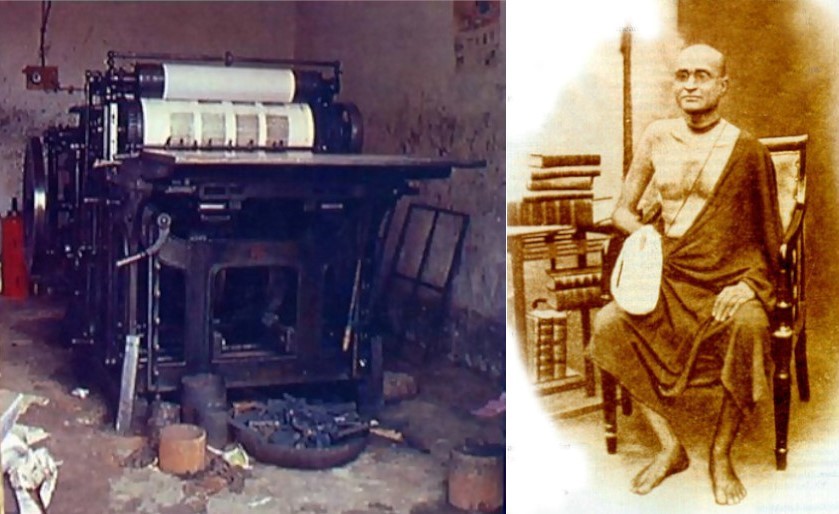
When challenged on how it was possible to publish a daily newspaper about God, Srila Bhaktisiddhanta Sarasvati Thakur explained:
Here in this world there are thousands of newspapers and magazines reporting the stale, repetitious happenings of this limited space. So for reporting the news of the unlimited spiritual realm, concerning the eternal, ever-fresh Supreme Personality of Godhead, we could publish a newspaper at every second, what to speak of daily.
Srila Sarasvati Thakur always emphasized kirtan and talks about Krishna and called his press the Brihat Mrdanga, meaning the Greater Mrdanga, which could be heard far and wide, as opposed to just a few blocks. His presses were the Bhagawat Yantra (Bhagawat Press) in Calcutta, the Gaudiya Printing Works in Calcutta, the Nadia Prakash Printing Press in Mayapura, and the Paramarthi Printing Works, in Cuttack, Orissa. He published the following magazines: Sajjana Tosani, established by Srila Bhaktivinoda Thakur and later re-named The Harmonist, an English monthly; The Gaudiya, the official weekly journal of the Gaudiya Math; The Nadia Prakash, an English/Bengali magazine and later a daily newspaper; The Bhagavata, a Hindi fortnightly; The Paramarthi, a fortnightly Oriyan magazine; and Kirtana, an Assamese monthly.
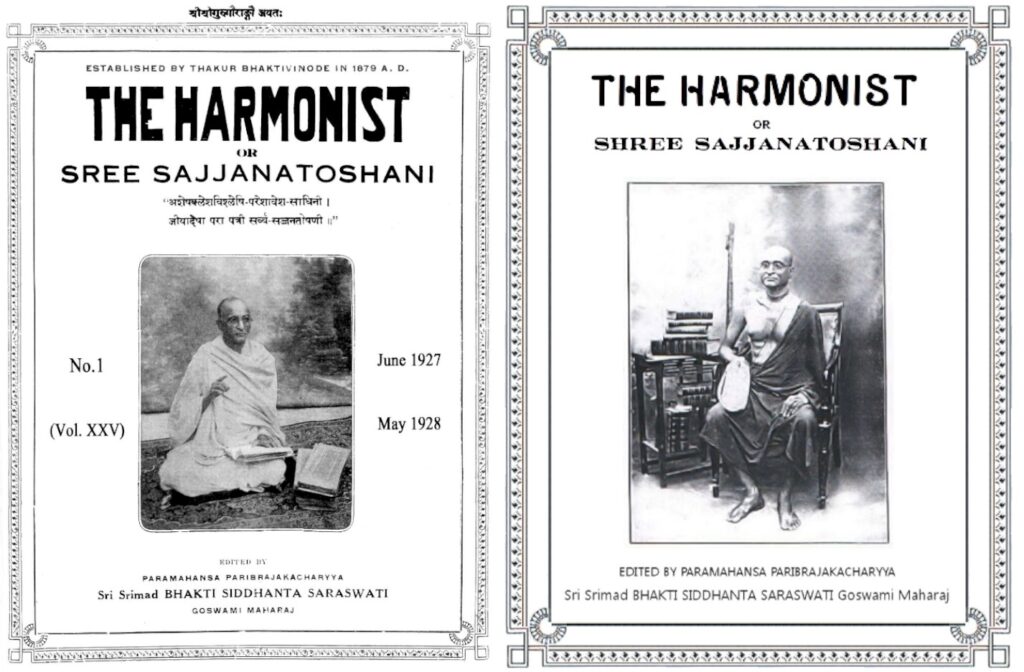
He personally wrote over 108 essays and books. Aside from these, he also published hundreds of articles in the Sajjana Tosani, Nivedana, Gaudiya, and Nadiya Prakash. Apart from his own writing, the Thakur also published many other books: the Bhagavad-gita with commentary by Srila Visvanatha Cakravarti Thakur, Srila Bhaktivinoda Thakur, etc., 12 Cantos of Srimad Bhagavatam, with commentary by Srila Bhaktivinoda Thakur, Srila Visvanatha Cakravarti Thakur, Srila Madhvacarya and others, the Caitanya-bhagavata with his Gaudiya Bhasya commentary, the Sri Caitanya Candramrta and Navadvipa-Sataka by Srila Prabhodananda Sarasvati, the Vedanta-tattvasara by Srila Ramanujacarya, the Mani-manjari by Srila Madhvacarya, the Sadacara-smrti by Srila Madhvacarya, the Navadvipa-dhama-granthamala by Srila Bhaktivinoda Thakur, an English version of the Sri Caitanya-bhagavata and 20,000 copies of Srila Narottama Das Thakur’s Prema-bhakti-candrika, the Sri Caitanya Mangala by Locana Das Thakur, the Brahma-samhita with Srila Jiva Gosvami’s comments and his own Gaudiya Bhasya. He also edited countless other books by his father.
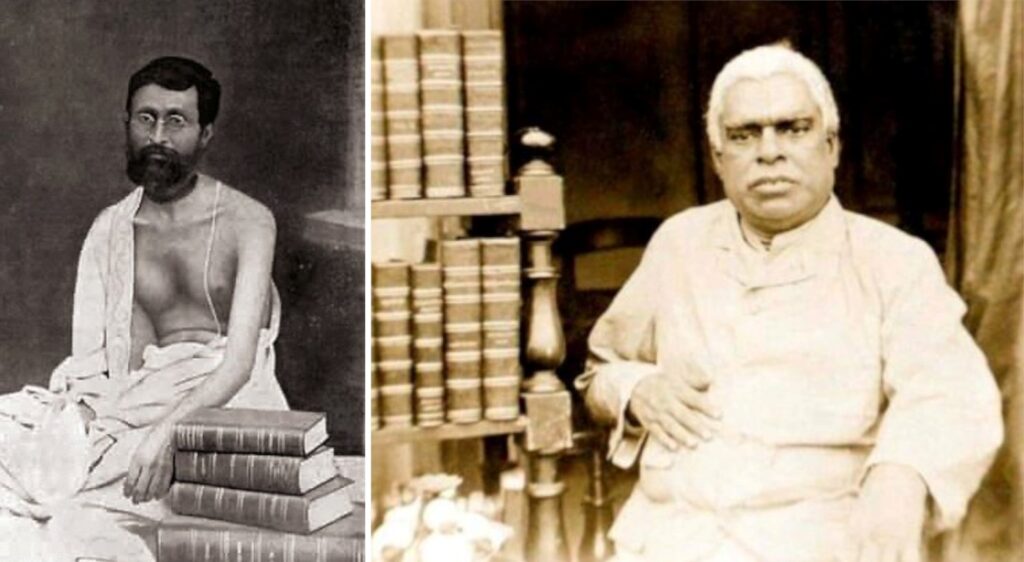
He met with many scholars, leaders and educators and established Krishna consciousness as a great science, worthy of the highest esteem. He had interviews and debates with the acharyas of other schools of thought and was never defeated, thus establishing the acintya-bhedabheda-tattva philosophy of Sri Chaitanya Mahaprabhu as the supreme doctrine of all time. He also propagated theistic displays and diorama exhibitions in Kuruksetra in 1928, 1933, and 1936, in Mayapur in 1930, in Calcutta in 1930, 1931, in Dacca in 1933, in Patna, Bihar in 1933, in Kasi (Benares) in 1933 and in Prayaga (Allahabad) in 1936. These exhibitions were free and were staged with the help of toys, dolls, pictures, writings and even mechanical devices for moving the dolls, describing the lilas of Lord Krishna, Lord Chaitanya, etc.
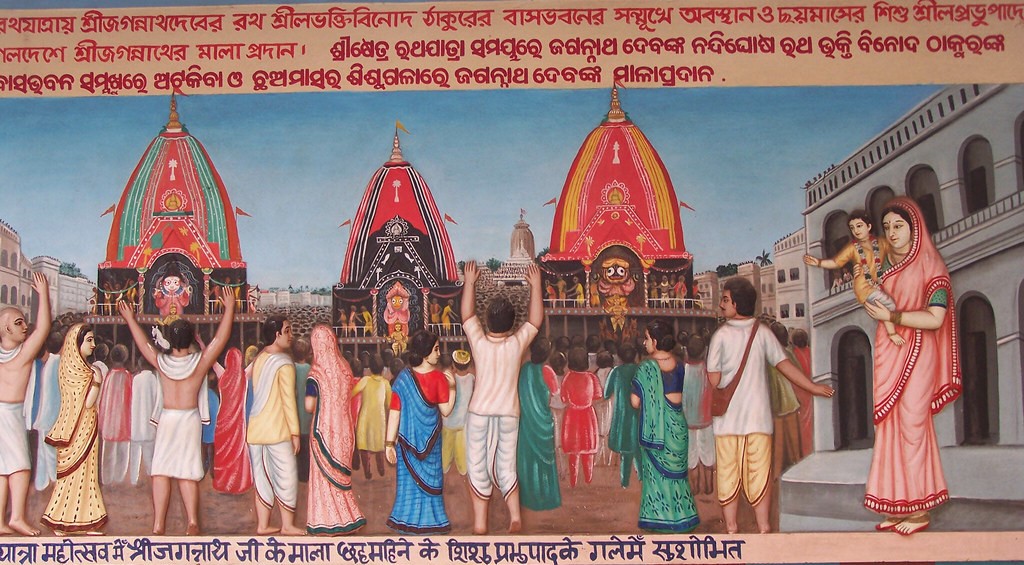
He also established several important parikramas of the Holy Dhamas, especially the Navadvipa Dhama Parikrama and the Vraja Mandala Parikrama, which were both originally set in motion by Sri Chaitanya Mahaprabhu Himself, setting the example as the greatest devotee of Krishna. The whole purpose of organizing these huge undertakings, in which thousands took part, was to arouse the awareness of the reality of the Lord’s pastimes in the minds of the pilgrims. He also discovered many pilgrimage sites of Lord Chaitanya and His associates’ pastimes and established Pada-pithas – Lotus Feet markers – on many sites of Sri Chaitanya Mahaprabhu’s preaching pastimes from His pilgrimage tour of India.
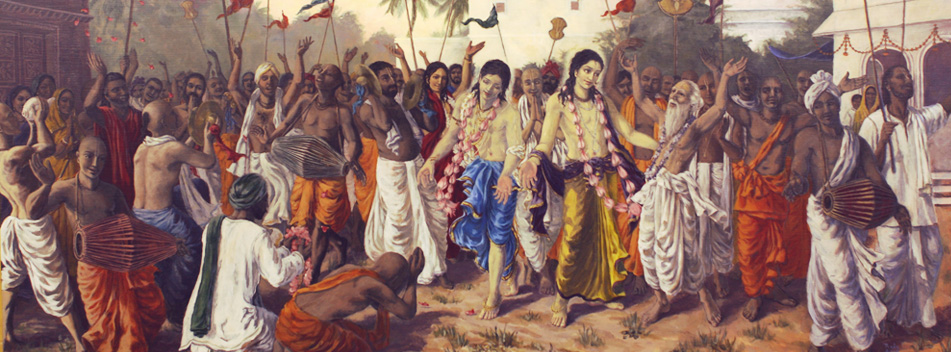
Srila Bhaktisiddhanta Sarasvati Thakur instructed and empowered Srila Bhaktivedanta Swami Prabhupad to deliver Vedic wisdom and the holy names of Krishna to the Western world. His struggle to establish Lord Chaitanya’s movement worldwide has laid the platform for Vaisnavism to break the bounds of India, and his contribution will be remembered by countless generations of Krishna devotees the world over.
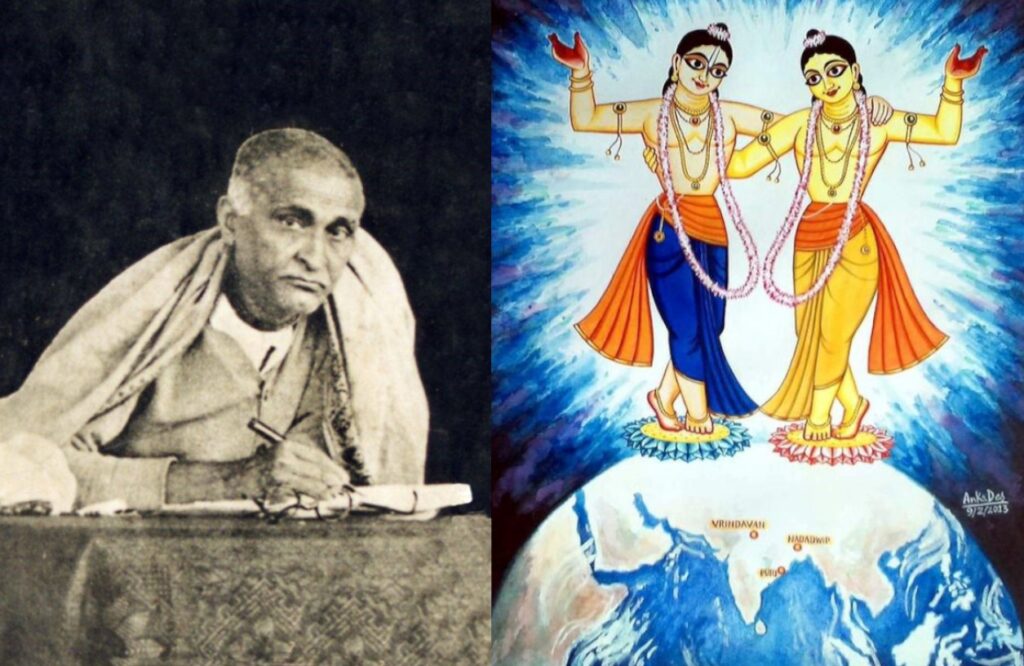
In Radha-Govinda’s eternal pastimes in Goloka Vrindavan, Srila Sarasvati Thakur serves as Nayana-mani Manjari. She and Kamala Manjari (Bhaktivinoda Thakur) are both confidential gopi assistants to Ananga Manjari, Radharani’s younger sister, and to Srila Rupa Manjari, who appeared in Lord Chaitanya’s time as Srila Rupa Goswami.
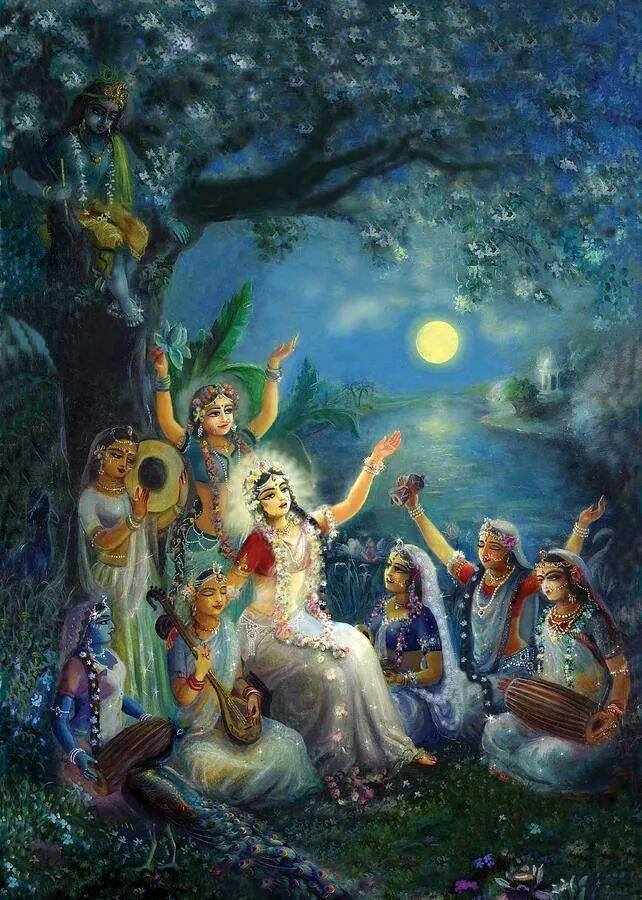
sri-varshabhanavi-devi-dayitaya kripabdhaye
krishna-sambandha-vijnana-dayine prabhave namah
I offer my respectful obeisances to Sri Varshabhanavi-devi-dayita das [another name of Srila Bhaktisiddhanta Sarasvati], who is favoured by Srimati Radharani and who is the ocean of transcendental mercy and the deliverer of the science of Krishna.

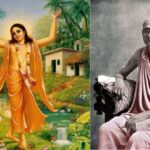
2 Comments
Jaya! Jaya!
Thankyou for sharing. It is such a deep blessing to read and hear and see. Namaste. Hari Bol ❤️!!!!